ELO2021-EXHIBITIONS => COVID E-LIT

ELO2021
All Exhibitions

Covid E-Lit
COVID-Exhibition Statement
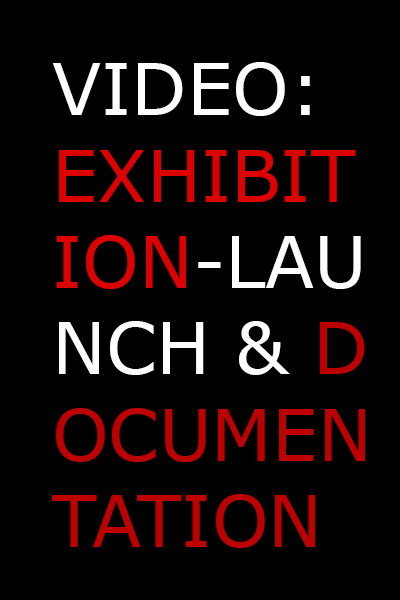
Video:Covid
Launch + Documentation
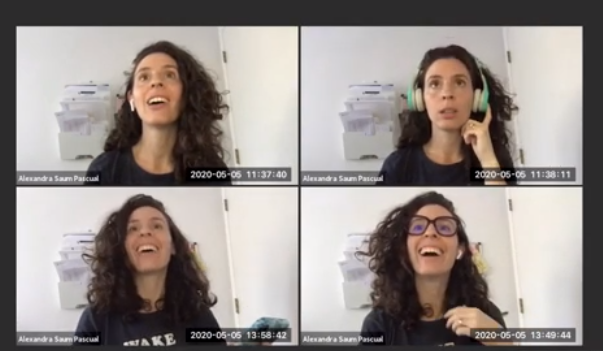
Alex Saum
Room #3
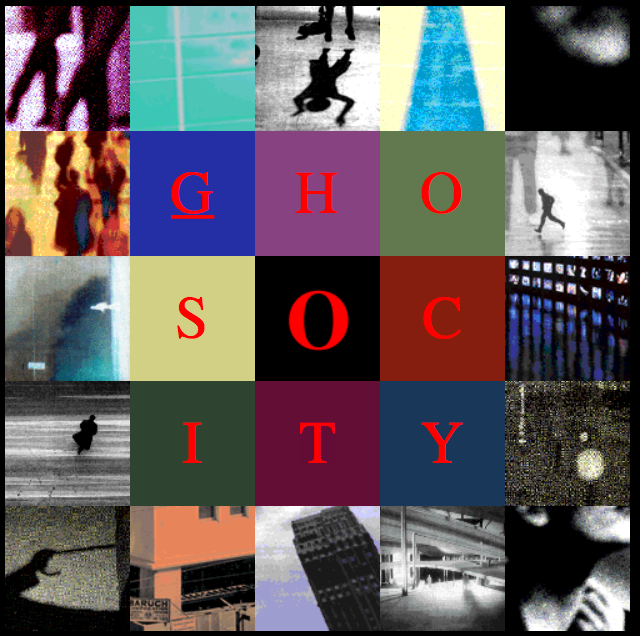
Jody Zellen
Ghost City Avenue-S
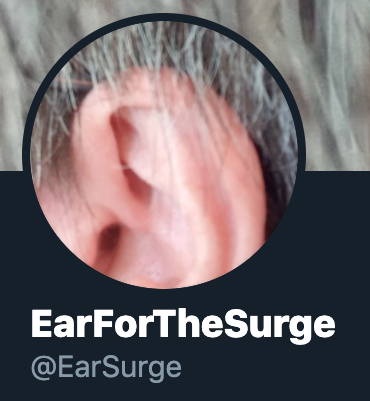
Claire Fitch
Ear for the Surge
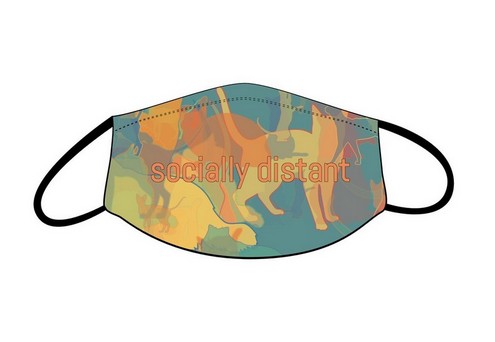
Lai-Tze Fan Anne Sullivan Anastasia Salter
Masked Making

Ben Grosser
The Endless Doomscroller
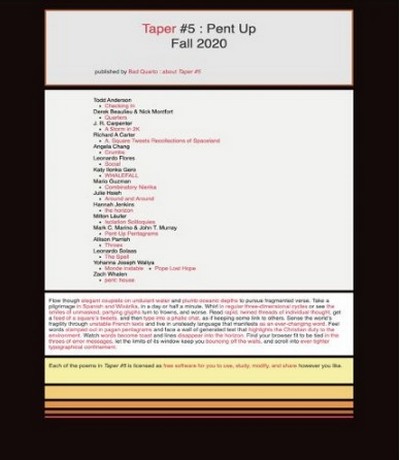
Kyle Booten + Angela Chang + Leonardo Flores + Judy Heflin + Milton Läufer
Taper #5
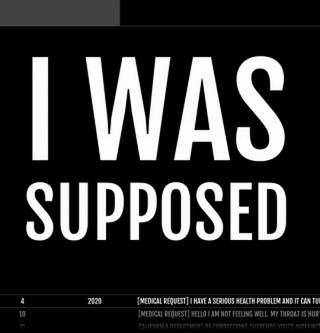
Sharon Daniel + Erik Loyer
EXPOSED

Mark Sample
Content Moderator Sim
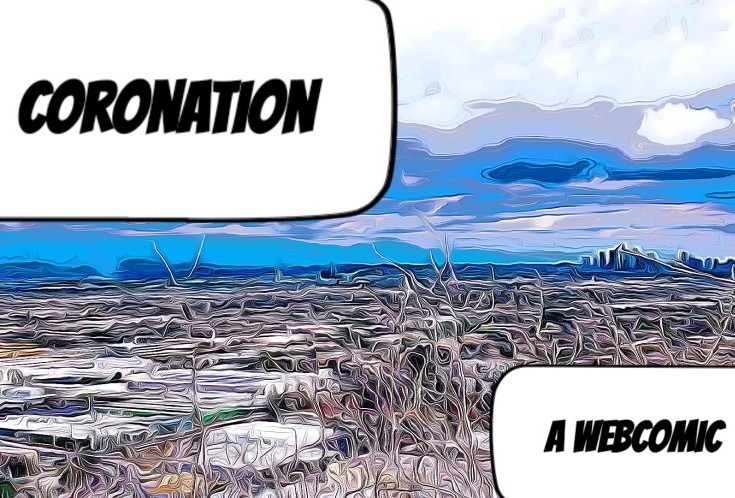
Marino Family
Coronation
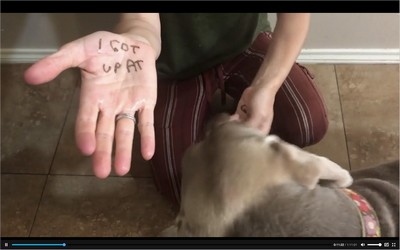
Xtine Burrough
I Got Up 2020, Pandemic Edition
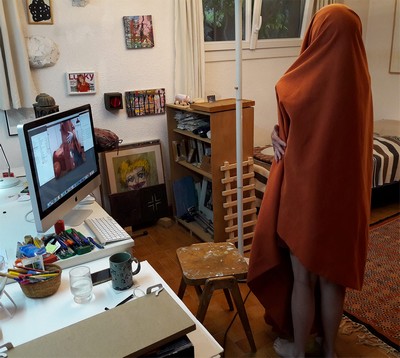
Annie Abrahams
Pandemic Encounter
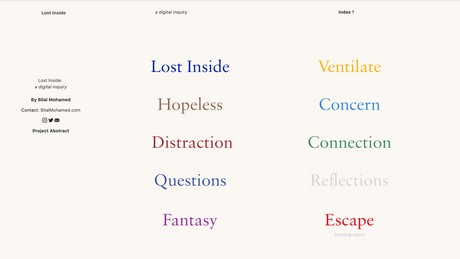
Bilal Mohamed
Lost Inside
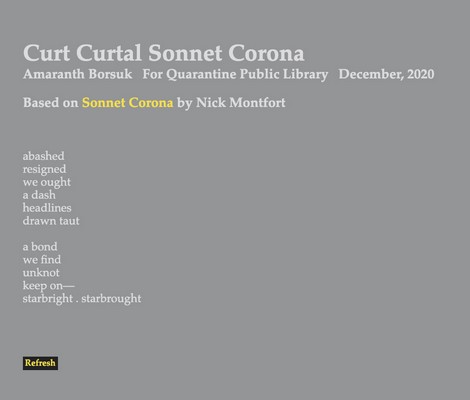
Amaranth Borsuk
Curt Curtal Sonnet Corona

Giulia Carla Rossi
The British Library Simulator
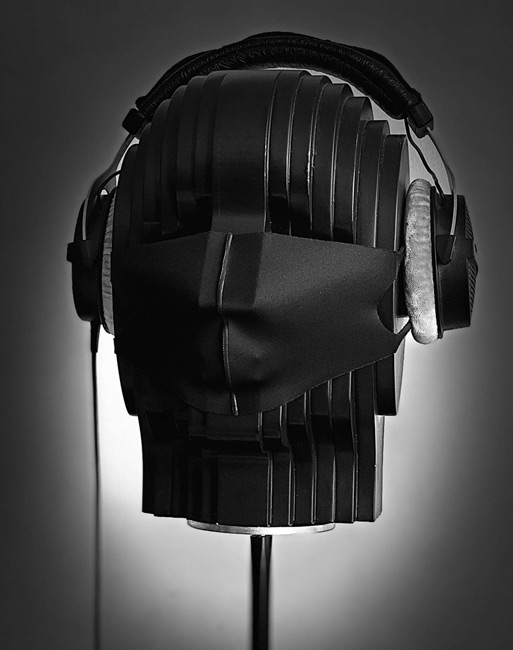
Lissa Holloway-Attaway,+
Jamie Fawcus
PATTER(n)INGS: Apt. 3B
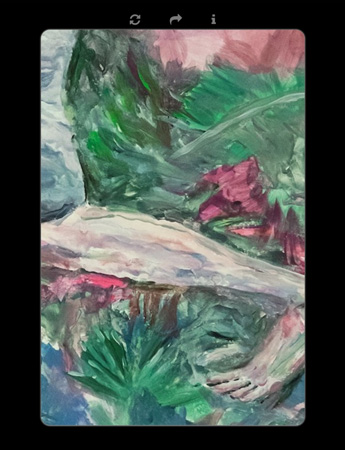
Diogo Marques+
João Santa Cruz+
Daniela Reis
RE\VERSE: an elegiac e-poem

Andanconnerdercu Utterings
Breathing

Alan Bigelow
Sentenced to Covid

Giselle Beiguelman
Coronário / Coronary
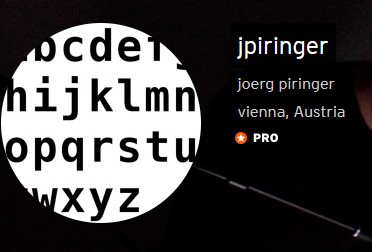
Jörg Piringer
The Complete COVID-19 Genome as a Sound Poem

Piotr Marecki, Kamil Gorgh Trzaska, Krzysztof Kaz, Michał Caruso
Polska przydrożna/Roadside Poland

René Bauer+
Beat Suter
ToniZ
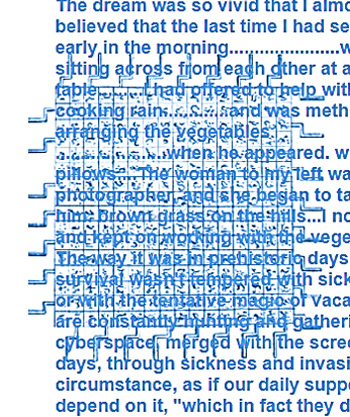
Judy Malloy
merged with the screen for days

Patrick Lichty
Confinement Spaces: Isolation. and Loss in the Pandemic

ELO2021
All Exhibitions
Six Themes: One Dispersed Exhibition
This is only one of many sites/portal/exhibition spaces that will appear in relation to the ELO2021 Conference.
Exhibitions for ELO 2021 will unfold on an extended time scale from March-May 2021. All exhibitions will be fully exhibited online, though some will also include local physical exhibitions.
The following exhibitions will be part of the festival:
Posthuman Electronic Literature.
An online exhibition with a projection exhibition component focused on electronic literature and media art that addresses posthumanism. To be featured during European SLSA conference at the University of Bergen. Curated by Joseph Tabbi, Scott Rettberg, Jason Nelson, Eamon O’Kane. MARCH 4-7, 2021.
COVID E-Lit.
An online exhibition of works that respond thematically to the pandemic and/or are produced within the specific context of platform culture during the pandemic. A library exhibition version of the exhibition will also be produced. Curated by Anna Nacher, Søren Pold, and Scott Rettberg. MAY 2021.
Flashback:
A special celebration of Flash and Shockwave e-lit held in the Electronic Literature Repository with artists on hand to talk about their work. Curated by Dene Grigar at Washington State University Vancouver’s Electronic Literature Lab. MAY 24-28, 2021.
Platforming Utopias (and Platformed Dystopias):
This will be the largest open submission exhibition, responding to the conference theme. MAY 24-28 2021.
Platform as a place of study - E-lit as already decolonised:
A series of exhibitions, workshops and activities focused on Indian and Asian E-Lit that will unfold through Spring 2021. MARCH-MAY 2021. Call will be announced separately. Curated by dra.ft
The dra.ft team from their ==> WEBSITE
Agat Sharma
- Theatre Maker. Educator. Designer.
Nanditi Khilnani
- Technical Program Manager turned Arts Professional. Classical Musician. Live Coder. Co-founder, Ajaibghar.
Ambika Joshi
- Museum Professional. Creative Coder. Certified Project Manager. Computational_Mama. Co-founder, Ajaibghar.
Kid E-Lit:
An online exhibition of electronic literature for young audiences, and work work by young authors. Curated by Mark Marino and Maria Goicoechea. MAY 24-28, 2021.
ELO2021 Exhibitions committee:
Lillian-Yvonne Bertram
Alan Bigelow,
Simon Biggs,
John Cayley,
Angela Chang,
Claire Donato
dra.ft:
-agat
-nanditi
-ambika
Astrid Ensslin,
Irene Fabbri,
Erika Fülöp,
Aud Gjersdal,
Maria Goicoechea,
Dene Grigar,
Ann Klingenberg,
Claudia Kozak
Milton Läufer,
Laurie Lax,
Erik Loyer,
Mark Marino,
Lucila Mayol,
John Murray,
Kat Mustatea,
Nick Montfort,
Anna Nacher,
Jason Nelson,
Eamon O'Kane,
Allison Parrish,
Søren Bro Pold,
Scott Rettberg,
Samya Brata Roy,
Carlota Salvador,
Winnie Soon,
Zach Whalen

COVID E-Lit
Exhibition Statement
Download ==> Print Version
Starting the preparatory phase of our research project almost one year ago, we were primarily interested in capturing the cultural moment of the then-nascent COVID pandemic through the lens of digital culture in general and electronic literature and digital art in particular. In the course of barely a couple of months in 2020, we witnessed the massive shift of transferring almost every aspect of our everyday life online. This quickly resulted both in an explosion of new forms of creativity and the acute syndrome of much-touted “Zoom fatigue”. The former were often mediated through popular platforms and brought new digital genres (such as Tik-Tok duets and the homemade reenactments of classic paintings), on top of already recognized but still under researched variants of meme culture or sometimes troubling discourse of subreddits.
Although with the COVID-19 crisis digital networked platforms took center stage and corporations like Facebook, Google, Apple and Zoom still form the main interfaces to our public space, soon it became obvious that the digital culture of the pandemic coincides with surprising and disturbing developments, such as the noticeable move of far-right extremism towards the open-source, niche, and independent platforms such as PeerTube, Pleroma, MeWe, Zello, or infamous Parler. Another visible feature of the massive online shift related to what Naomi Klein has named “Screen New Deal”, where commercial technology platforms are introduced to a much larger extent and integrated with our private spaces and homes, is the development of new forms of critical reflection, e.g. about how platforms invade privacy, intimacy, individual spaces and simultaneously collaboration, communities, cultural and political life. Such a reflection often takes the form of digital artwork, available for download and functioning as the browser plug-in or add-on.
Yet, it seems the pandemic not only created a distinctive crisis of its own, but also exacerbated the ones that have long been in the making. Underfunded and inefficient public healthcare and education systems were the first to undergo the shock of sudden failure. In light of the famous Stafford Beer’s observation known as POSIWID (the purpose of the system is what it does), such failures became particularly illuminating and sobering to many who were prone to believe that the rich countries of the global North can maintain their global dominance and endless development at the expense of the environment and colonized “others”, including those suffering along the lines of various oppressive ideologies and systems of domination: racial, gender, class, ideological, and economic.
Achille Mbembe in his illuminating essay “The Universal Right to Breathe” aptly remarks: “Before this virus, humanity was already threatened with suffocation” and warns that following the hitherto path will bring further destruction on an already unprecedented scale, where the economy of extraction based on and favoring fossil fuels is inevitably interlinked with our super-efficient and energy-hungry digital world. This is why we were also interested in how the pandemic digital art and e-literature tackled the wider crises of our contemporaneity: climate change, racial injustice, gender inequality and social inequality. Many works developed during this time are then reflective of public clashes and rebellion, e.g. in relation to Black Lives Matter, during a period in which dominant power structures are exposed and actively questioned. Furthermore, there are many works mourning the deceased, the sick, as well as the loss of human connections that were not long ago taken for granted.
On the other hand, since the outbreak of the pandemic, public libraries, theatres, museums, and cultural festivals have been closed to various degrees across many countries and much cultural life and many creative practices have moved online, along with their audiences. This alone posed significant challenges to the whole cultural sector, but was also seen as a chance to find new ways of communicating and new solutions to make cultural life more accessible to the various types of audiences. It seems, in the pandemic we have been collectively mourning the lost space of shared human presence and want to believe this loss is only temporary. This hope is being reflected in many artworks in the exhibition that confine with the near space, locality, nature, various constraints impacting embodiment practices, the home and homely.
It has also manifested as a uniting thread running through the interviews we have conducted with many of the artists in the exhibition as an attempt at documenting our encounter with the artists and their work - embodied feelings and the treasured shared presence of our human body/minds around was discussed by each and every artist we talked to over Zoom in March 2021, working on a forthcoming documentary skillfully produced and videographed by Ashleigh Steele.
For many pandemic crisis has been experienced as both an intense, extended period relieved from FOMO, and as sheer boredom and utter restlessness. Most of us have experienced the intrusion of platforms like video conferencing into our very living rooms and bedrooms, which has led to the emergence of critical awareness but also to a way of getting used to being together across screens. In this sense, old distinctions between online and offline, the virtual and the physical and perhaps even art and reality have somewhat diffused themselves into new hybrids. And digital artists and elit authors reflect on analogue matters like bodies, homes, concrete environments and physical conflicts. Maybe we see traces of a new cultural moment, a sort of final goodbye to the false ideas of a weightless postmodernity, living in a mixture of digital media and reality that is no less real.
When this exhibition opens, we are more than a year into the pandemic experience. We have realized that the global is not elsewhere but directly interlinked with our infrastructures, travel, supply chains, contagion networks, etc. We are global, even when we are local and subject to lockdown and travel bans. The pandemic demonstrates that we are all connected, but it also points out that the conditions are still very different between rich and poorer countries, between countries on the same continents, neighborhoods in the same city or young and old citizens. We have been forced to live locally confined. In some cases this has been an enlightening and even spiritual experience, in other cases it has been a disaster. Our friends in dra.ft group in India are even now confronting a devastating surge in cases and deaths.
When we started discussing the Covid 19 and electronic literature, we reflected on the fact that, while there are many public memorials related to wars, there are very few related to epidemics and diseases. Apart from the horrible scenes we have seen from hospitals around the world, the everyday of the pandemic has for many of us mostly been visible through its lack of the normal, as closed down, deserted cities. There is something unrepresentable about a pandemic caused by an invisible virus. This exhibition portrays all this through art and electronic literature as, we hope, an already historical monument of life under the pandemic. We believe the exhibition demonstrates that the pandemic, besides all its horrors and cancellations, has also been a genuine moment for art and electronic literature.
--Anna Nacher, Søren Pold, and Scott Rettberg
May 1, 2021
Exhibition Artists:
Alex Saum | Room #3
This video performance work explores how corporate language relates to that other corpora that is the body. A supposedly private conversation between four replicas of the artist gives unto the realization that it, like millions of others, is being recorded, analyzed, and datamined by its platform-host, Zoom.
Jody Zellen | Ghost City Avenue-S
“Avenue S” is a new addition to Zellen’s sprawling piece “Ghost City,” active since 1998. It is an ongoing creation of net art pages containing fragmented images and texts that are a poetic meditation on isolation, nature, walking, politics, and protests during the pandemic. Wander from page to page by clicking on the red boxes; stumble across hidden links; and enjoy the piece’s many surprises.
Claire Fitch | Ear for the Surge
A work about rage, designed to be heard. Found texts covering topics such as COVID-19, Black Lives Matter, online protest, and themes of renewal, uncertainty, and change are reworked into hexameter and put into sound and video -- spoken word, stitched together.
Lai-Tze Fan, Anne Sullivan, and Anastasia Salter | Masked Making: Uncovering Women’s Craft Labor During COVID-19
An endless, interactive imagetext generates imaginary masks representing the lives and thoughts of the fictional people who have made them, centering both crafted object and crafter as ephemeral and disposable. The fictional crafters in this piece reflect public examples of real-life crafters in news articles and social media posts, representing the wealth of diversity, age groups, and communities that participate in collective mask making today.
Ben Grosser | The Endless Doomscroller
A lens on our software-enabled collective descent into despair. By distilling the news and social media sites down to their barest most generalized messages and interface conventions, “The Endless Doomscroller” shows us the mechanism that’s behind our scroll-induced anxiety: interfaces -- and corporations -- that always want more.
Kyle Booten, Angela Chang, Leonardo Flores, Judy Heflin, Milton Läufer, eds. | Taper #5: Pent Up
Taper is an online literary journal for computational poetry and literary art published twice yearly by Bad Quarto. Amidst global “social distancing,” the editorial collective issued an open call for works to reflect upon or chafe against our pandemic-induced confines. The editors sought inspirational pieces to make it easier to pass the time, reach out to others, or thrive while limited to only “virtual” society. In the phrase “Pent Up,” pieces also evoked the (false) etymology of the number five (pentagons, pentameters).
Sharon Daniel and Erik Loyer | EXPOSED
EXPOSED documents the spread of COVID-19 inside prisons, jails, and detention centers from the perspective of prisoners, detainees, and their families. Quotes, audio clips, and statistics collected from a comprehensive array of online publications and broadcasts are assembled into an interactive timeline that, on each day, offers abundant testimony to the risk, trauma, and extreme isolation that prisoners experience under coronavirus quarantine.
Mark Sample | Content Moderator Sim
Play as a subcontractor whose job is to keep your social media platform safe and respectable. The game tasks you with either approving or removing social media posts that users have flagged and critiques the role social media platforms have played in contributing to disinformation, conspiracy theories, and intolerance since the beginning of the pandemic.
The Marino Family | Coronation: A Webcomic
Coronation documents the Marino family’s experience of the pandemic. Since lockdown began in downtown Los Angeles over a year ago, they’ve published one comic per day, five days a week, using a combination of digital filters, graphics applications, photographs from family albums, screenshots, downloads from web-based news sources, and hand-drawn images.
Xtine Burrough | I Got Up 2020, Pandemic Edition
Made during the pandemic, these daily vignettes interpret ‘getting up’ as unusually labor intensive -- creative on the best days and merely possible on the worst. We see Burrough confined to her house while enacting the roles of mother, artist, housekeeper, and teacher. This series is inspired by On Kawara’s 1968 - 1979 ritual of sending postcards stamped with the time he ‘got up’ to two friends each day.
Annie Abrahams | Pandemic Encounter
Breathing is usually an unconscious process shared by all persons, but during the pandemic, it has become a common source of anxiety. This audio track exteriorizes the raw, raspy discomfort of our new reality. It mixes the artist’s respiration; computer-generated, distorted heartbeats; and a sound piece called “Silences” by Frans van Lent, which captures the silences of twenty artists from all around the world.
Bilal Mohamed | Lost Inside: A Digital Inquiry
A COVID-era digital journal inspired by J.R Carpenter's “Entre Ville” comprised of hypertext, intimate entries, and personal and visual perspectives highlighting a state of stasis brought on by the quietude and uncertainty of the outer world. The purpose of this work is to create an intimate space for rumination on the experience of life under quarantine and a pandemic.
Amaranth Borsuk | Curt Curtal Sonnet Corona
At the start of the COVID-19 pandemic, Nick Montfort published “Sonnet Corona,” a tiny program that can generate a crown of 3^14 or 4,782,969 potential sonnets. Its 14 monometer lines evoke the enclosure and uncertainty of the early lockdown. “Curt Curtal Sonnet Corona” utilizes Montfort’s code to generate 4^11 or 4,194,304 curtal, 11-line sonnets with 4 variables per line.
Lissa Holloway-Attaway and Jamie Fawcus | PATTER(n)INGS: Apt. 3B
An interactive audio experience that moves between deep materiality and immaterial illusion, all reconstructed by a single eavesdropper-user, also ideally in semi-isolation. It explores themes of intimacy, proximity, disruption, and mediation during a pandemic lockdown through audio-only documentation of suspended being(s) inside the many rooms of Apt. 3B (wherever that is).
Giulia Carla Rossi | The British Library Simulator
A short browser-based game first published in June 2020 while the Library buildings were closed, giving visitors a chance to learn interesting facts about its physical location and about the Library as a whole. At the time, it kept the public abreast of services the Library continued to provide even during lockdown, highlighting ongoing projects and digital content that could still be accessed from home.
Diogo Marques, João Santa Cruz, and Daniela Reis | RE\VERSE: an elegiac e-poem
Following a random plus (pre-)combinatorial logic, 40 textual verses and 40 pictorial fragments intertwine in order to provoke a self-reflexive reading of the verse(s) and reverse(s) characterizing the experience of confinement. Combined, image and text (un)veil a dialogic path that, although necessarily entropic, is made of continuous renewal.
Piotr Marecki, Kamil Gorgh Trzaska, Krzysztof Kaz, and Michał Caruso | Polska przydrożna / Roadside Poland
An anti-racer designed for the 8-bit Atari, immersed in demoscene aesthetics and the general climate of retro games. Roadside Poland references the book Polska przydrożna by Marecki, where the protagonist wriggles around small towns in the Polish countryside instead of straightforwardly traveling. The demo itself is devoid of elements characteristic of racers (car, speed, movement, attractive landscapes), testifying to the pandemic time in which it was made.
René Bauer and Beat Suter | ToniZ
ToniZ.ch is the digital twin of Toni Areal, the building that houses the Zurich University of the Arts. After the March 2020 lockdown, the building was completely shut off for several months. ToniZ.ch tries to (ironically, symbolically) reclaim some of it for students and teachers. Bachelor and Master graduation ceremonies were held in it, with all students and teachers present and able to interact with each other.
Judy Malloy | merged with the screen for days
In “merged with the screen for days,” computer-generated stanzas move across a four-array structure and play together unpredictably, permitting multiple views if the reader generates several versions. It simulates the computer-mediated environments that dominated our lives in 2020. The history of generative poetry is referenced in the background by Jonathan Swift's Lagado Engine from Gulliver's Travels.
Patrick Lichty | Confinement Spaces: Isolation. and Loss in the Pandemic
An existential visual narrative of living in the United Arab Emirates under lockdown from March - August 2020, created using scans of the local landscape taken with an iPhone and 3D scanning software. The work features a series of twelve interactive spaces rendered as pastiches of the eighty-two scanned spaces made during the first half-year of the pandemic, resulting in a glitched, dream-like experience.
Andanconnerdercu Utterings | Breathing
Confronts the viewer with a “being” that is the result of an intricate, active, interlaced communicative structure in which both humans and machines are involved in a process of shared auditory exchange and attention. Through the mixing of six audio and video streams emerges an image of a phantom-like breathing, pulsating entity that thrives through affection, attention, glitches, delays and even voids.
Alan Bigelow | Sentenced to Covid: Voices of the Pandemic
Displays single-sentence responses to the pandemic that stretch the full length of a screen, sliding into view a single letter at a time. Responses can be read in manual or auto mode, and visitors to the site can write their own responses for others to see.
Giselle Beiguelman | Coronário / Coronary
A hypertextual essay about the cultural experience of the coronavirus, with emphasis on Brazilian daily life. It features a set of 25 words popularized in the context of the pandemic such as Zoom and lockdown, supplemented by a small glossary. A heat map dynamically highlights the words visitors to the site check in this lexicon. Those most accessed by the audience change their color on a scale that varies from blue (cooler) to red (hotter and, therefore, more accessed).
Thanks to Carlota Salvador Megias for editing the work descriptions above.

Video: Covid
Launch + Documentation
link = Video
Video of the Covid Exhbition Launch
Artists showcasing their works
Featuring the artists, curators and designs of the Covid exhibition
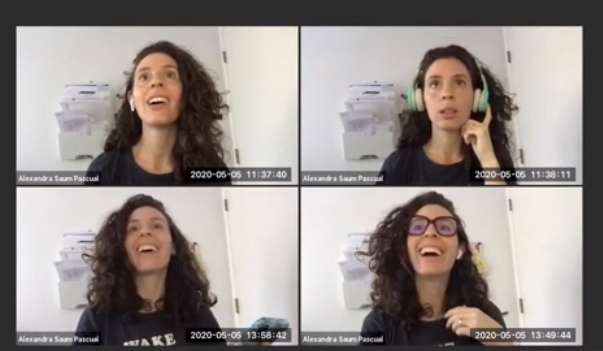
Alex Saum
Room #3
link = Room #3
Connection to Theme:
Nothing captures the experience of 2020's pandemic like making a video conference call. Be it for work or personal reasons, most of us opened our domestic life to the online world via these platforms; Zoom probably rising to the top of the list. Personal space became public in our desire or requirement to connect, and these platforms became a new room in most of our homes.
This piece, Room #3, engages these ideas by presenting a peculiar Zoom call by me and a set of copies of myself to question these kinds of connections: always alone in the physical space, but always connected in unexpected ways to a multitude of known interlocutors and unknown human and non-human agents.
Artwork Description:
Room #3 is a cross-over piece between two projects, The Offline Website Project (TWOP) and Corporate Poetry. Originally an HTML website meant to never leave my home computer, it now circulates as a video documenting the experience of one of my interactions with my own website.
Thematically, as part of the larger Corporate Poetry, it explores how corporate language relates to that other corpora that is our bodies. The piece includes a short 40-second introduction to TOWP and then it moves to a Zoom conversation between 4 replicas of me who experience traditional Zoom issues such as audio problems, turned off cameras and so on.
This goes on loop for a bit, until the supposedly private conversation with myself expands onto the realization that this conversation, like millions of others (also depicted into new screens with violent and uncensored content), is being recorded, and all their information analyzed to serve Zoom’s unselective data gathering purposes.
Biography:
Alex Saum-Pascual is a digital artist, poet and professor. She is author of #Postweb! Crear con la máquina y en la red (Iberoamericana-Vervuert 2018) and numerous articles on digital media and literature in the Spanish-speaking world. Her digital artwork and poetry has been exhibited in galleries and art festivals in the United States, Canada, Mexico, Spain, Norway and the UK.
Currently, she is Associate Professor of Contemporary Spanish Literature and New Media at the University of California, Berkeley. She is also part of the Executive Committee of the Berkeley Center for New Media and the board of directors of the Electronic Literature Organization."
==>> Artist's Website
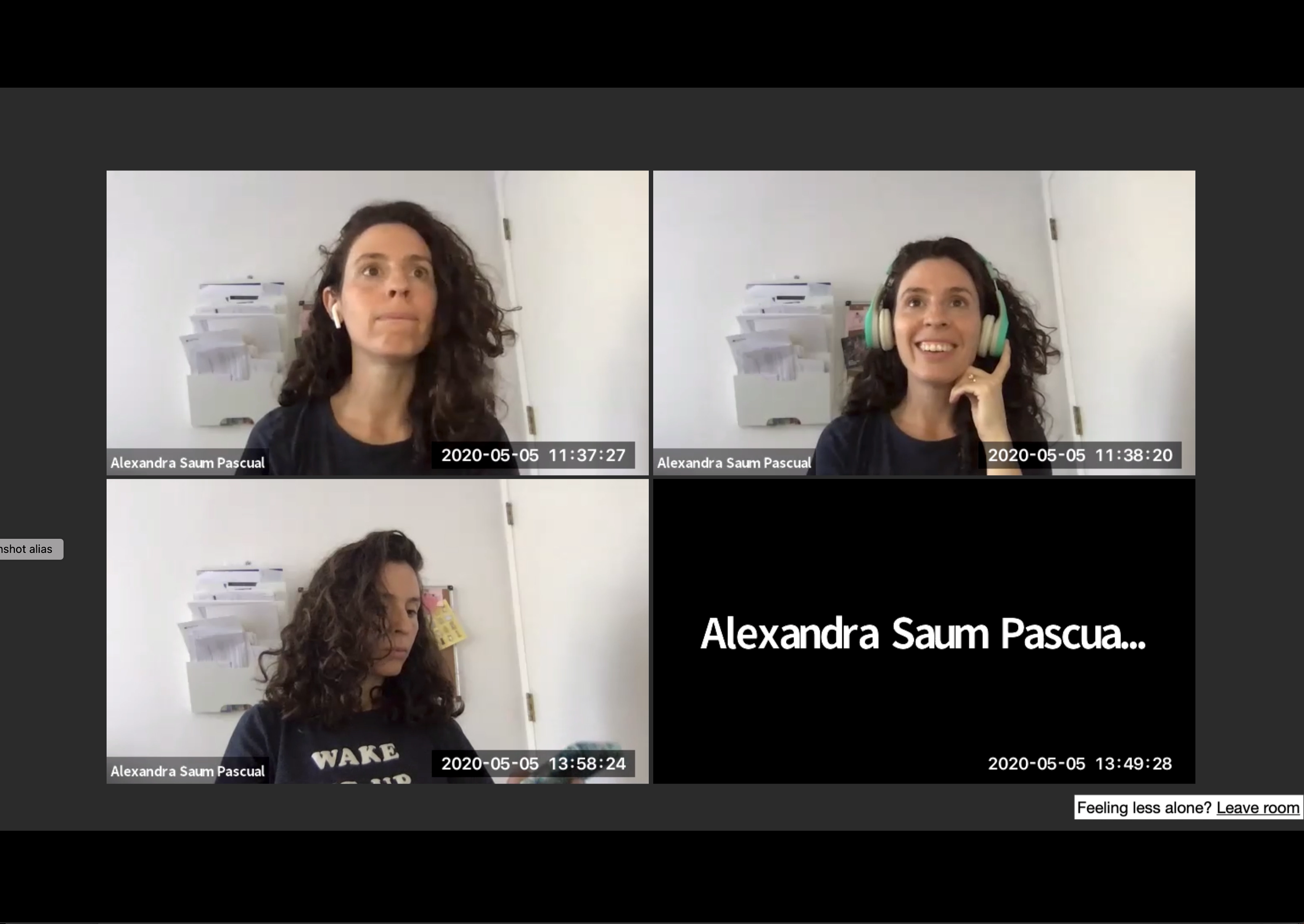
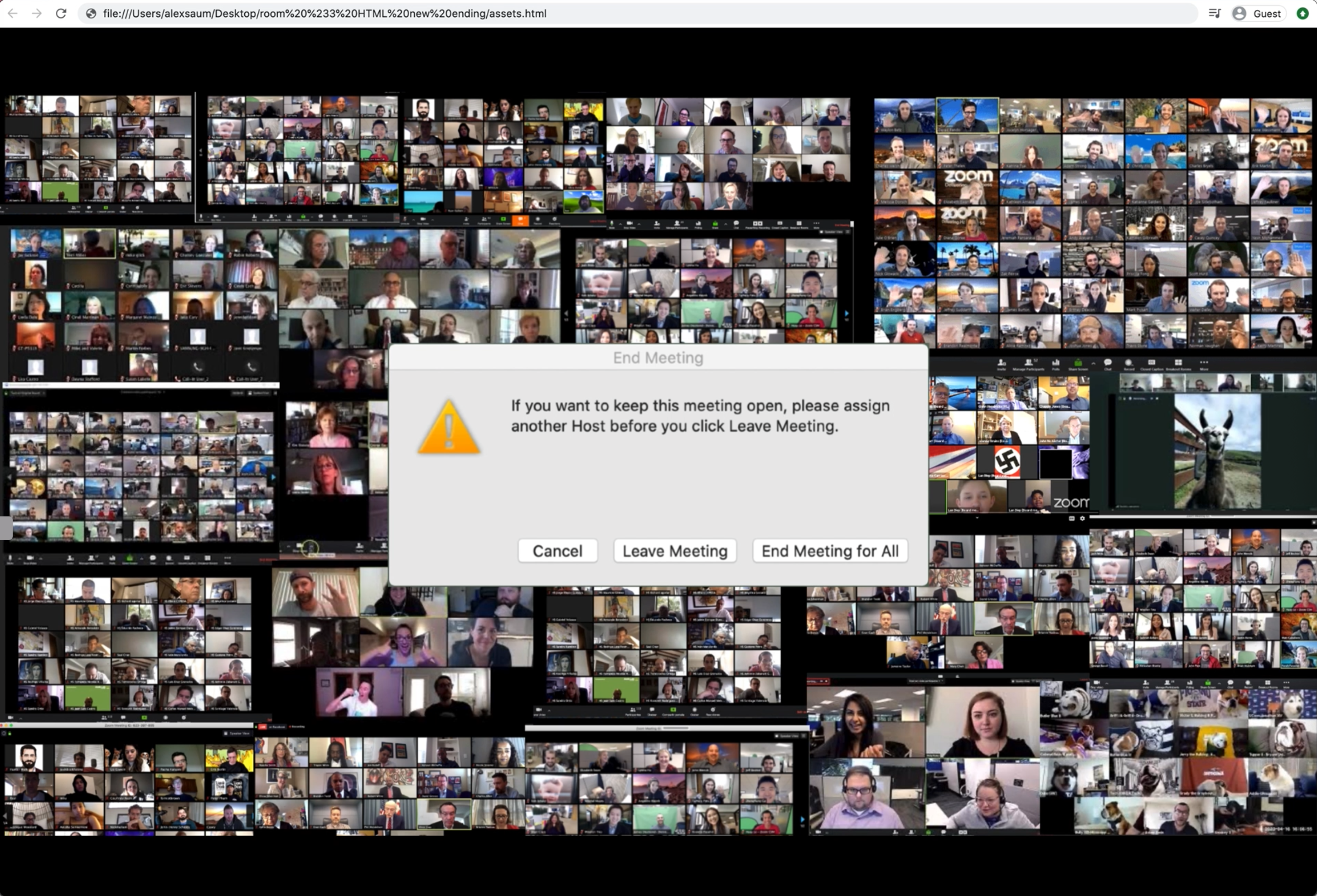
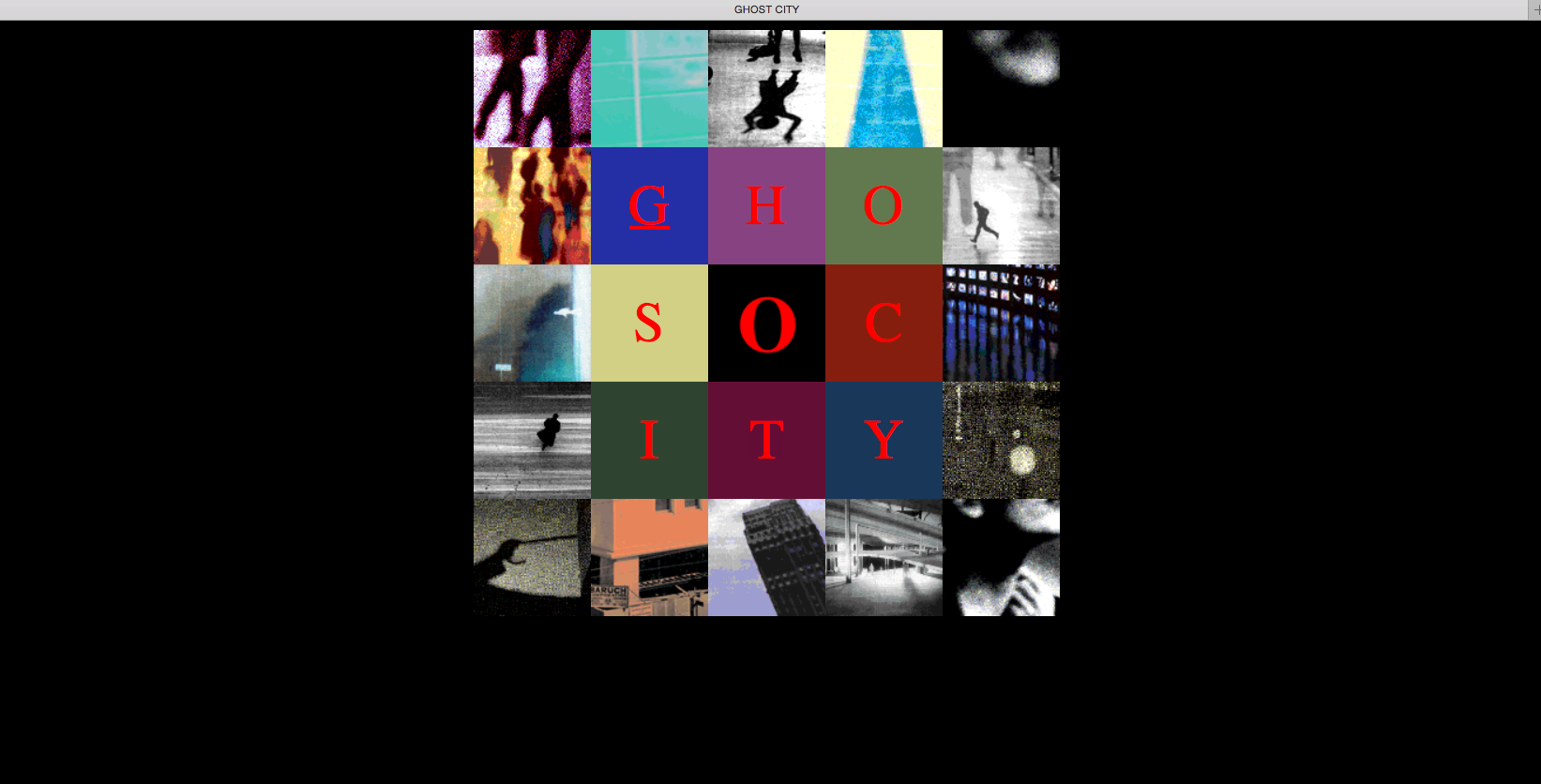
Jody Zellen
Ghost City Avenue-S
link = Ghost City Avenue-S
Connection to Theme:
As the pandemic spread in early 2020, Jody Zellen began to build a new neighborhood in her Ghost City website (www.ghostcity.com/avenue-s) called Avenue S.
It came about because suddenly the world was like a ghost town, the streets were empty, the beaches and parks closed. As people stayed at home or walked alone wearing masks, she wanted to provide an alternative experience. Week by week, she continues to add images, rollovers, poetic texts and animations to the site and has now created hundreds of unique webpages.
Artwork Description:
Avenue S is a meditation on disconcerting times—a reflection on isolation, nature, walking, politics and protests. It is an active viewing experience.
The red boxes at the bottom of each page are links to the next page, yet there are also hidden links and many surprises. Avenue S is meant to be a fragmentary experience, just like life today— a maze within the pandemic and also, just possibly, a path out.
Biography:
Jody Zellen is a Los Angeles based artist who makes interactive installations, mobile apps, net art, animations, drawings, paintings, photographs, public art, and artists' books.
She constantly thinks about ways to use new technologies and to integrate interactivity into her artworks.
Zellen received a BA from Wesleyan University (1983), a MFA from CalArts (1989) and a MPS degree from NYU's Interactive Telecommunications Program (2009). Her site specific interactive installations include: “The Unemployed," Los Angeles International Airport (2019); “News Wheel,” Long Beach City College, (2017); “Time Jitters,” Halsey Institute of Contemporary Art (2014) and “The Blackest Spot," Fringe Exhibitions, Los Angeles, (2008).
==>> Artist's Website <<==
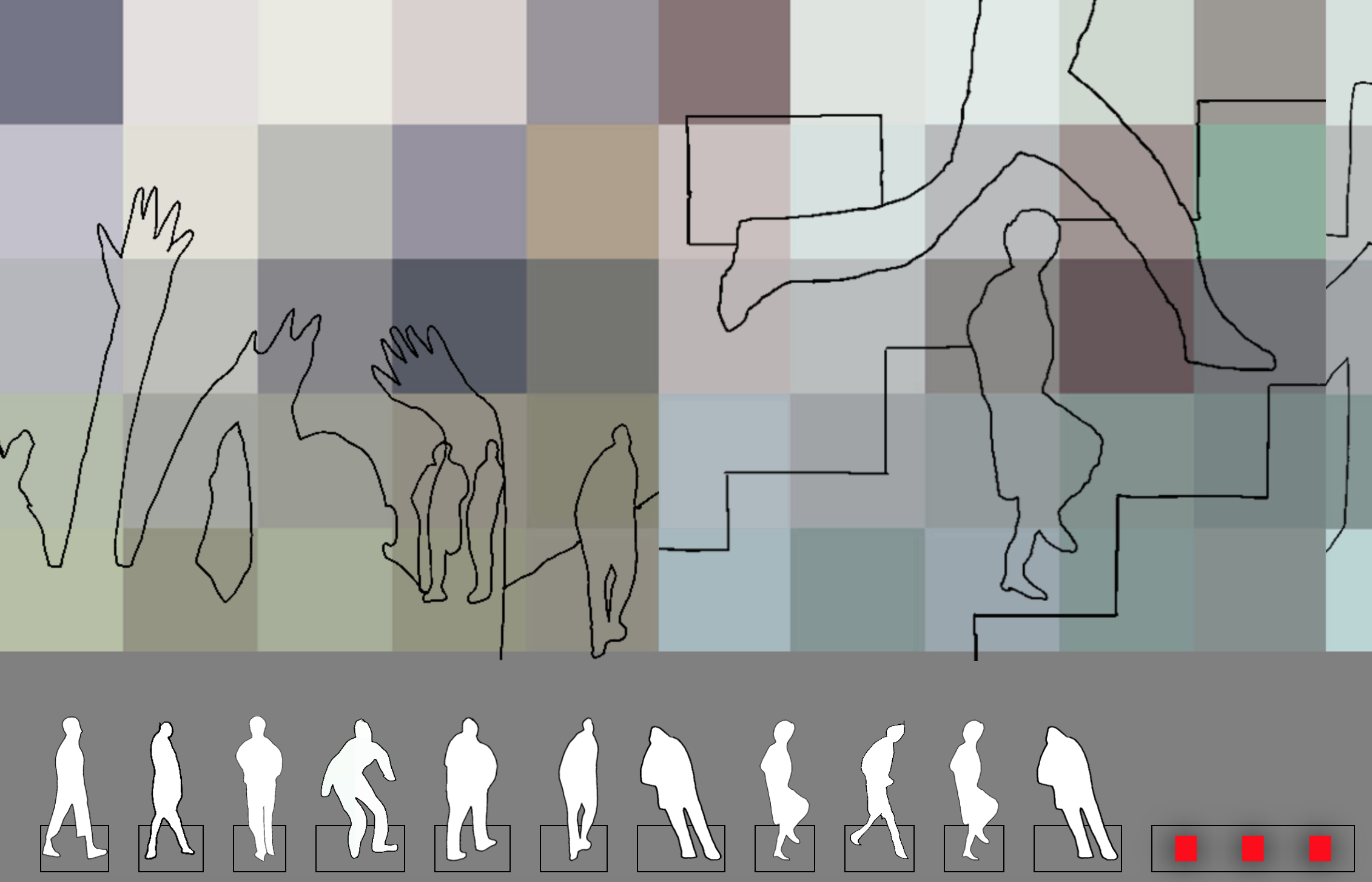
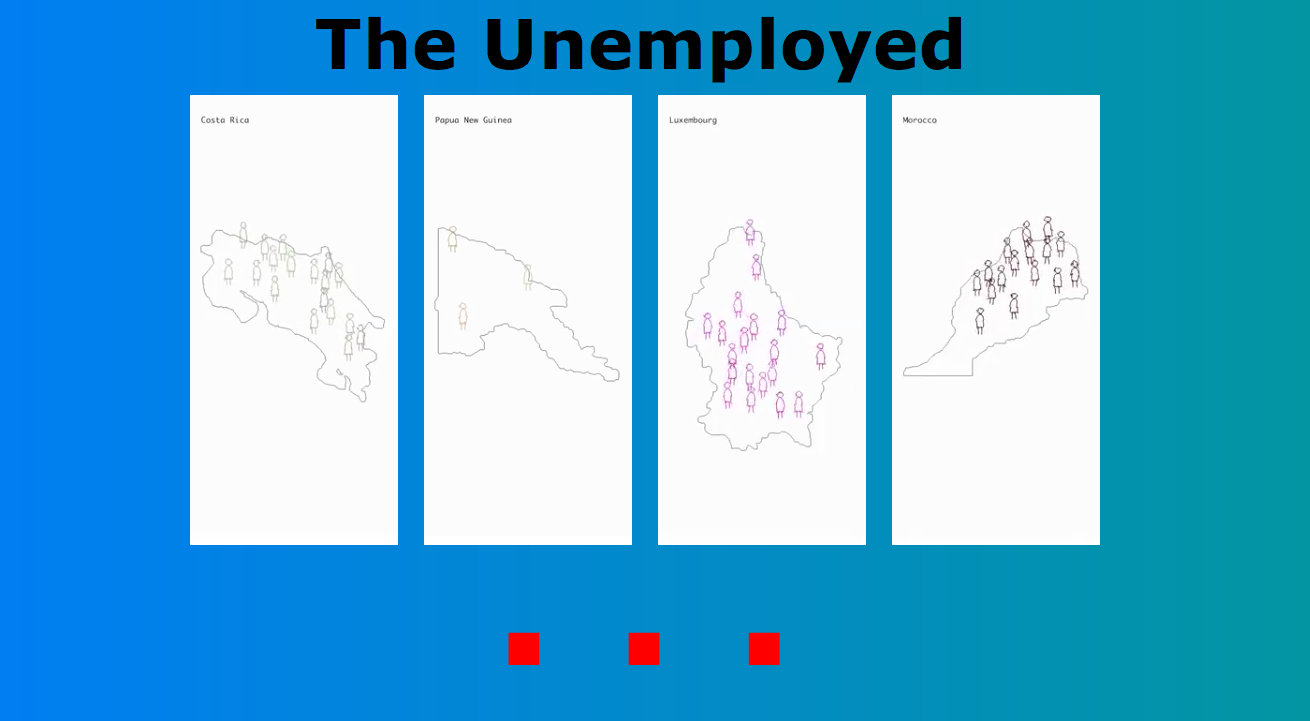
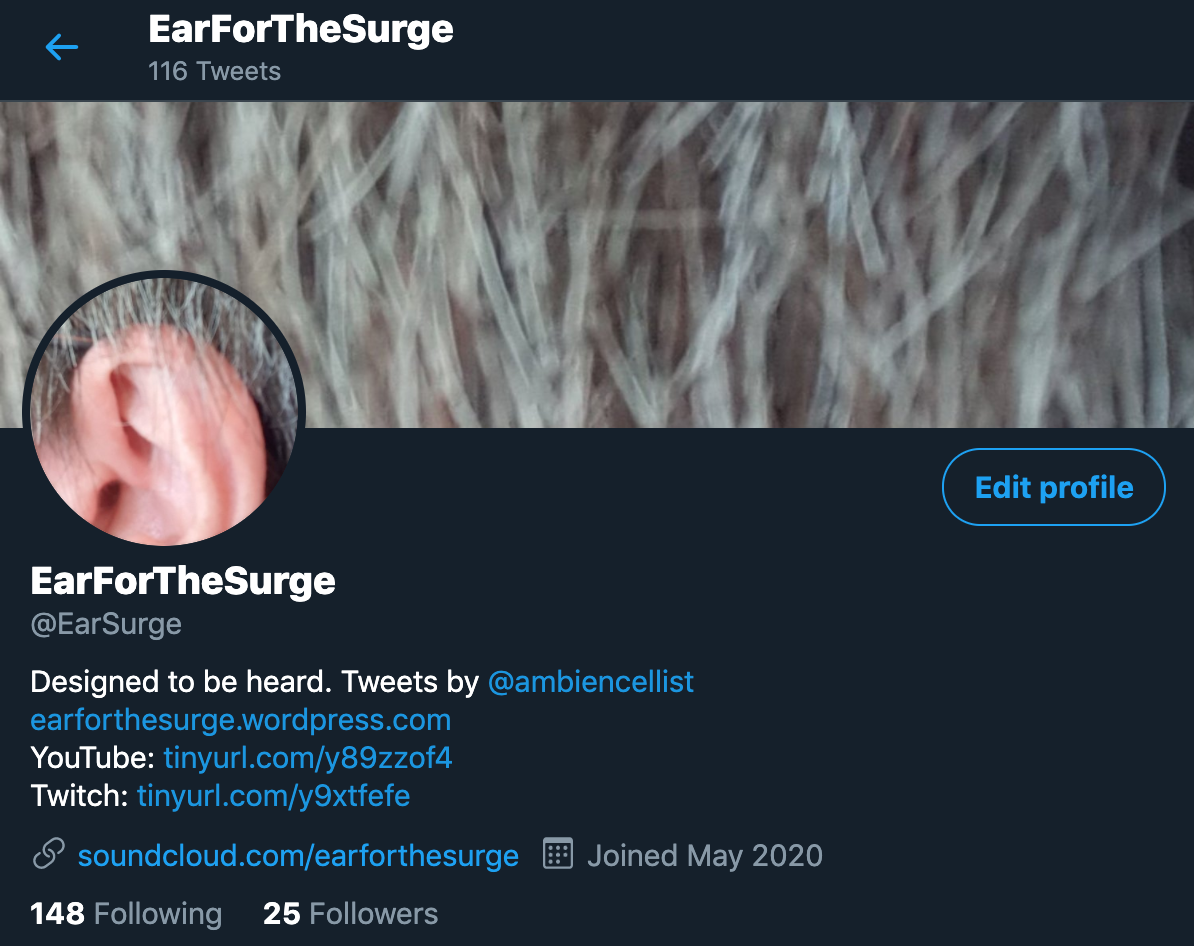
Claire Fitch
Ear for the Surge
link = Ear for the Surge
Connection to Theme:
Artwork Description:
Ear For The Surge is designed to be heard. A work about rage, inspired by Homeric hexameter and coronavirus. Spoken word, stitched together, woven into layers of pain, inequality and sadness. Text from internet search terms developed after hearing constant news, constant cries for help, and raging people. Sound text became the basis for an ongoing hexameter, sound, and video.
Biography:
Claire Fitch is a composer, inspired by sound, e-lit and games; a lecturer at Dundalk Institute of Technology; a lapsed cellist, previously working for RTÉ; and is busy writing a text to be published by Routledge in 2021.
==>> Artist's Website <<==

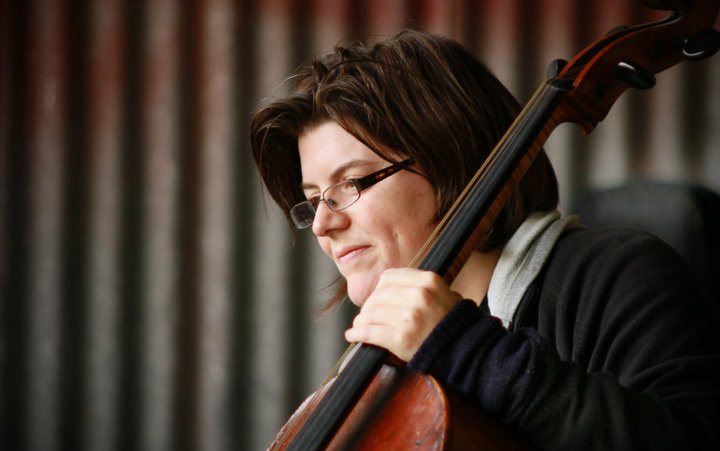
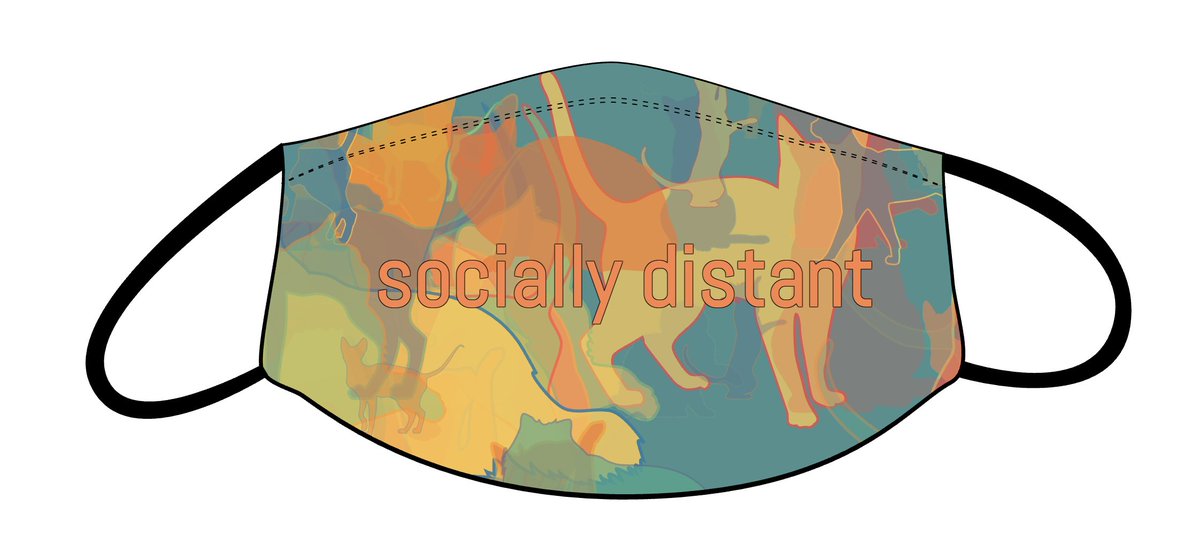
Lai-Tze Fan + Anne Sullivan
+ Anastasia Salter
Masked Making:
Uncovering Women's Craft Labor during Covid-19
link = Masked Making
Connection to Theme:
In the United States in 2020, face masks became a political symbol: first welcomed as part of assisting emergency workers, and later condemned as a threat to individual liberty, the face mask is an inescapable site of conflict. However, it is also a thing of labor, entwined with the domestic sphere of sewing.
At the start of the pandemic in March 2020, several news stories emerged about essential objects in the pandemic, as well as various responses to these objects. Included in these stories were so-called “hobbyists,” mainly women, who used sewing machines and even needle and thread to make Personal Protective Equipment, including gowns, hair nets, and especially face masks.
Indeed, hundreds of thousands face masks have been crafted by collectives of home sewers, frequently led by and including mainly women donating their time and resources. Their example of collective labor prompts the need to think of the usually invisible forms of making that occur in socially “private” and feminized spaces of labor—such as sewing rooms, kitchens, and offices—as active forms of contribution to safe social practices, altruism, and community-based maker cultures.
Masked Making is a work that keeps its origins in mind: the interactive work will be available online for participants to engage with as a form of knowledge mobilization outreach, communicating the significance of women’s contributions to public audiences as well.
Artwork Description:
In this exhibition, we center this labor, using generative graphics and texts to imagine those masks: in an endlessly cycling generator, we capture both the imagined making and brief fragments of text centering the imagined, forgotten, and invisible makers who power this collective effort.
Built using Tracery, HTML5, and Javascript, this endless interactive imagetext generates imaginary masks that represent the lives and thoughts of the fictional people who made them. The fictional crafters in this piece reflect public examples of the crafters during COVID-19 --such as collected news items, social media images, and personal reflections--that are gathered to represent the wealth of diversity, age groups, and communities that participate in collective mask making.
Sharing these publicly available resources will more faithfully represent and thus uncover the faces, hands, and labor of mask making during COVID-19. This exhibition invites the viewer to contemplate not only the mask itself, but also the erasure of primarily women, whose collective labor has been ignored, mocked, and diminished even as the US faces a horrifying setback in gender labor equity.
By using a format in which content is constantly being generated, Masked Making centers both the crafted object and its crafter as ephemeral and disposable. In doing so, we hope to capture the marginalization of craft at a time when such domestic labor (and indeed, the confinement to the domestic) is literally life-saving.
Biography:
Dr. Lai-Tze Fan is an Assistant Professor of English at the University of Waterloo, Canada, and a Faculty Researcher of the Critical Media Lab, Data Science Institute, and Games Institute. She researches digital storytelling, media theory and infrastructure, research-creation and critical making, and systemic inequalities in the design of techology and technological labour.
Fan makes digital and material art about e-waste, crafts, and fashion.
Dr. Anne Sullivan is an Assistant Professor of Digital Media in the School of Literature, Media, and Communication at Georgia Tech and is the director of the StoryCraft Research Lab. Her research focuses on playful and storied interactive experiences from a feminist perspective, emphasizing craft.
Dr. Sullivan is the designer of Loominary – a digital game system controlled with a loom - which has shown internationally, including the SAAM Arcade at the Smithsonian American Art Museum.
Dr. Anastasia Salter is the Director of Graduate Programs and Associate Professor of English for the College of Arts and Humanities, including the interdisciplinary doctoral program in Texts and Technology, at the University of Central Florida.
They have authored seven books, including most recently Twining: Critical and Creative Approaches to Hypertext Narratives (Amherst College Press 2021, w/ Stuart Moulthrop) and Portrait of the Auteur as Fanboy (University of Mississippi Press 2020).
==>> Fan's Website <<==
==>> Sullivan's Website <<==
==>> Salter's Website
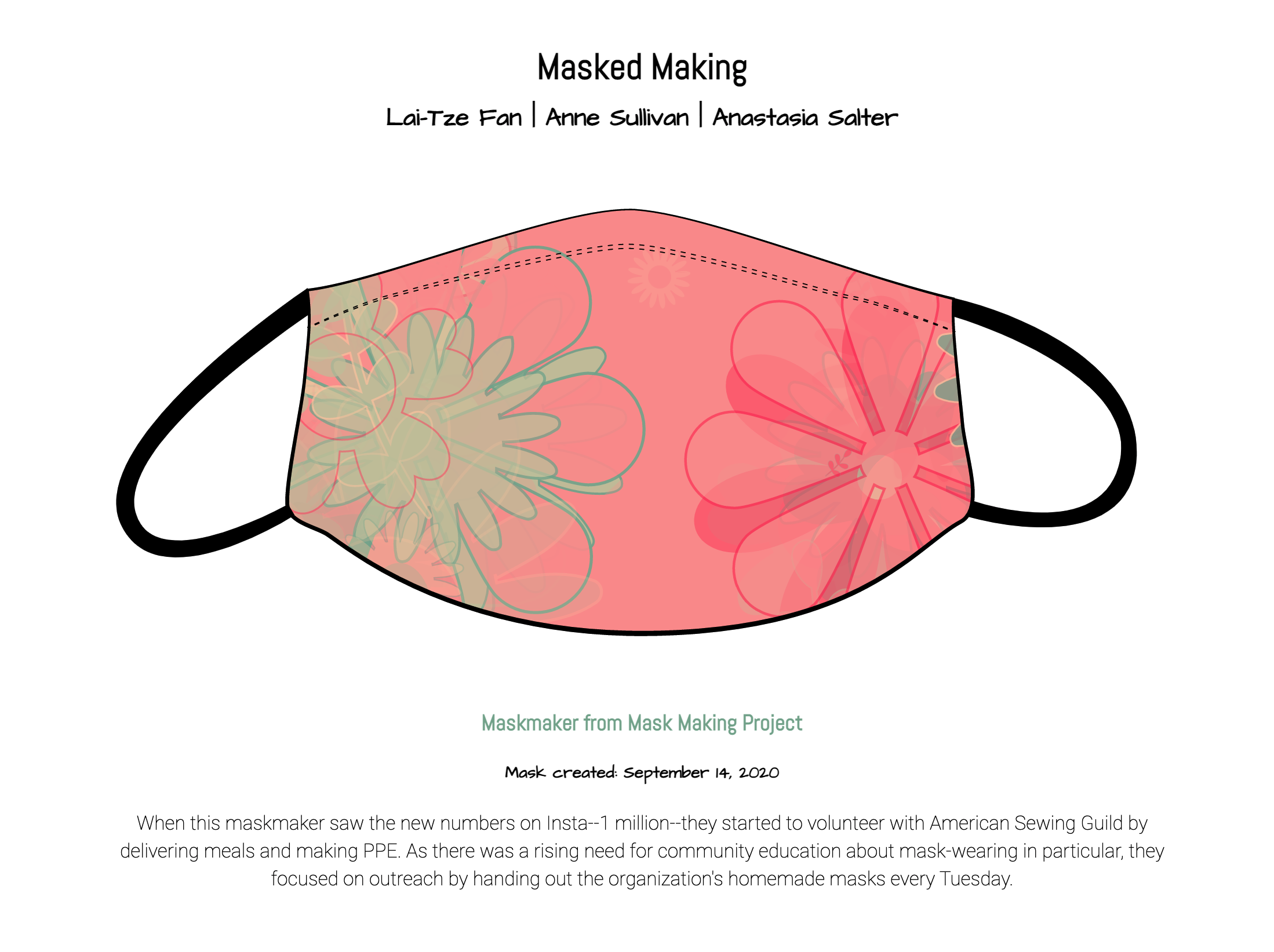


Ben Grosser
The Endless Doomscroller
link =The Endless Doomscroller
Connection to Theme:
“Doomscrolling” refers to the ways in which people find themselves regularly—and in some cases, almost involuntarily—scrolling bad news headlines on their phone, often for hours each night in bed when they had meant to be sleeping. Certainly the realities of the pandemic necessitate a level of vigilance for the purposes of personal safety.
But doomscrolling isn’t just a natural reaction to the news of the day—it’s the result of a perfect yet evil marriage between a populace stuck online, social media interfaces designed to game and hold our attention, and the realities of an existential global crisis.
Yes, it may be hard to look away from bad news in any format, but it’s nearly impossible to avert our eyes when that news is endlessly presented via designed-to-be-addictive social media interfaces that know just what to show us next in order to keep us “engaged.”
Artwork Description:
As an alternative interface, The Endless Doomscroller acts as a lens on our software-enabled collective descent into despair. By distilling the news and social media sites down to their barest most generalized messages and interface conventions, The Endless Doomscroller shows us the mechanism that’s behind our scroll-induced anxiety: interfaces—and corporations—that always want more.
More doom (bad news headlines) compels more engagement (via continued liking/sharing/posting) which produces more personal data, thus making possible ever more profit.
By stripping away the specifics wrapped up in each headline and minimizing the mechanics behind most interface patterns, The Endless Doomscroller offers up an opportunity for mindfulness about how we’re spending our time online and about who most benefits from our late night scroll sessions. And, if one scrolls as endlessly as the work makes possible, The Endless Doomscroller might even enable a sort of exposure or substitution therapy, a way to escape or replace what these interfaces want from and do to us.
In other words, perhaps the only way out of too much doomscrolling is endless doomscrolling.
Biography:
Ben Grosser creates interactive experiences, machines, and systems that examine the cultural, social, and political effects of software.
Recent exhibition venues include the Barbican Centre in London, Museum Kesselhaus in Berlin, Museu das Comunicações in Lisbon, and Galerie Charlot in Paris. His works have been featured in The New Yorker, Wired, The Atlantic, The Guardian, The Washington Post, El País, Libération, Süddeutsche Zeitung, and Der Spiegel.
The Chicago Tribune called him the “unrivaled king of ominous gibberish.” Slate referred to his work as “creative civil disobedience in the digital age.” Grosser’s artworks are regularly cited in books investigating the cultural effects of technology, including The Age of Surveillance Capitalism, The Metainterface, Critical Code Studies, and Technologies of Vision, as well as volumes centered on computational art practices such as Electronic Literature, The New Aesthetic and Art, and Digital Art.
Grosser is an associate professor in the School of Art + Design, and co-founder of the Critical Technology Studies Lab at the National Center for Supercomputing Applications, both at the University of Illinois at Urbana-Champaign, USA.
==>> Artist's Website <<==
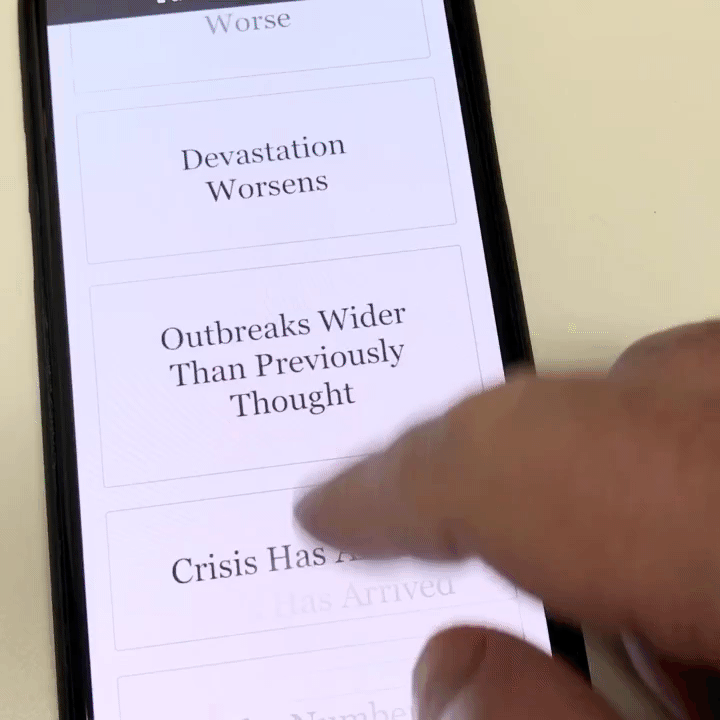
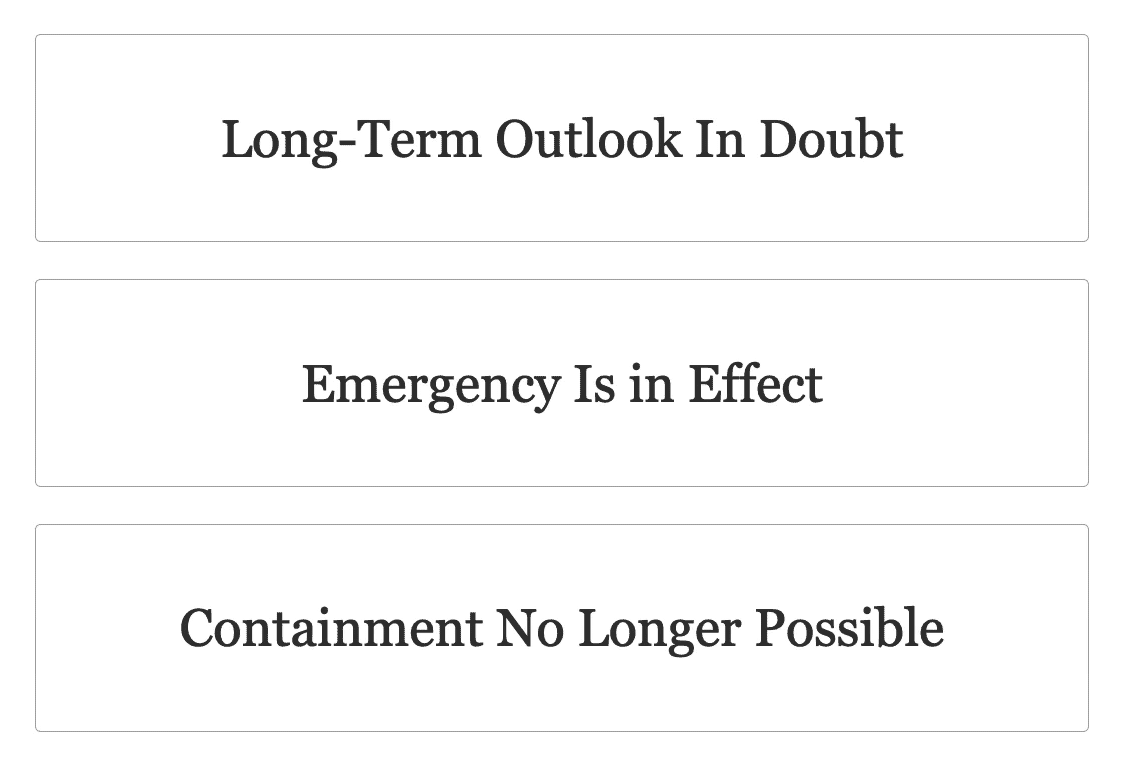
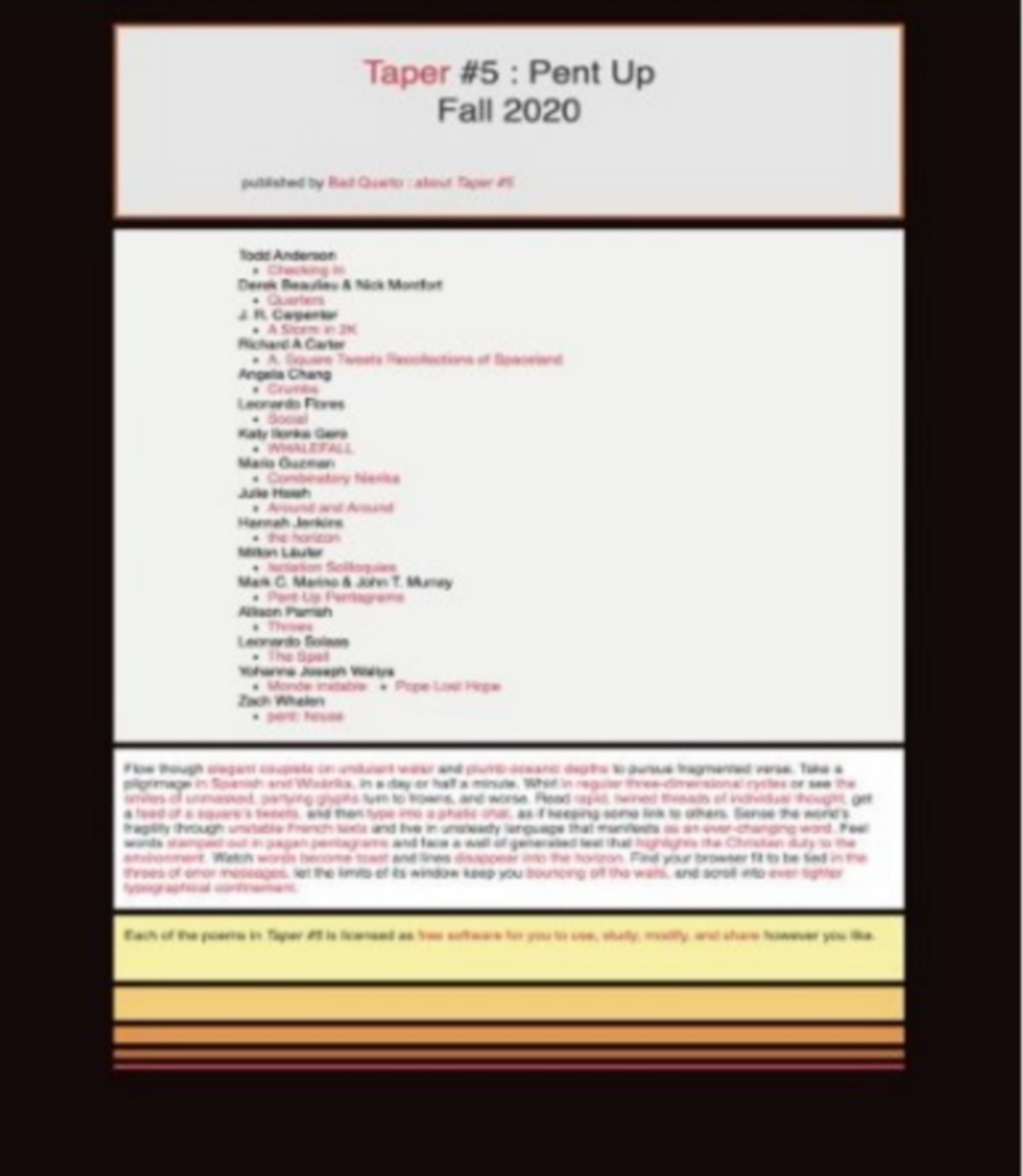
Kyle Booten + Angela Chang
Leonardo Flores + Judy Heflin
Milton Läufer
Taper #5:
Pent Up
link = Taper #5
Connection to Theme:
In Taper #5: Pent Up, we published seventeen works from authors based in eight countries, written in four languages (including Wixárika), all reflecting on the global crisis caused by COVID-19.
Artwork Description:
Amidst global “social distancing,” the editorial collective issued an open call for works to reflect upon or chafe against our pandemic-induced confines. We sought inspirational pieces to make it easier to pass the time, reach out to others, or thrive while limited to only “virtual” society.
In the minimalist spirit of Taper, works could embrace compression, austerity, and secrecy. In the phrase “Pent Up,” pieces also evoked the (false) etymology of the number five (pentagons, pentameters), as this fifth issue encouraged authors to reflect on the issue number’s significances and shapes.
Biography:
Taper is an online magazine, or digital zine, that presents minimal electronic literature works exploring new visual, linguistic, literary, and computational territory.
Taper is inspired by the Oulipo’s combination of constraints with computation as a fertile ground for literary creativity. The work in it also relates to practices of sizecoding in the demoscene.
Taper’s poems explore the poetic possibilities of the World Wide Web and JavaScript through concise expression. Artists are constrained to develop creative works that are no more than 2KB, inspired by a number and theme.
==>> Kyle Booten's Website <<==
==>> Angela Chang's Website <<==
==>> Leonardo Flores's Website <<==
==>> Judy Heflin's Website <<==
==>> Milton Läufer's Website <<==


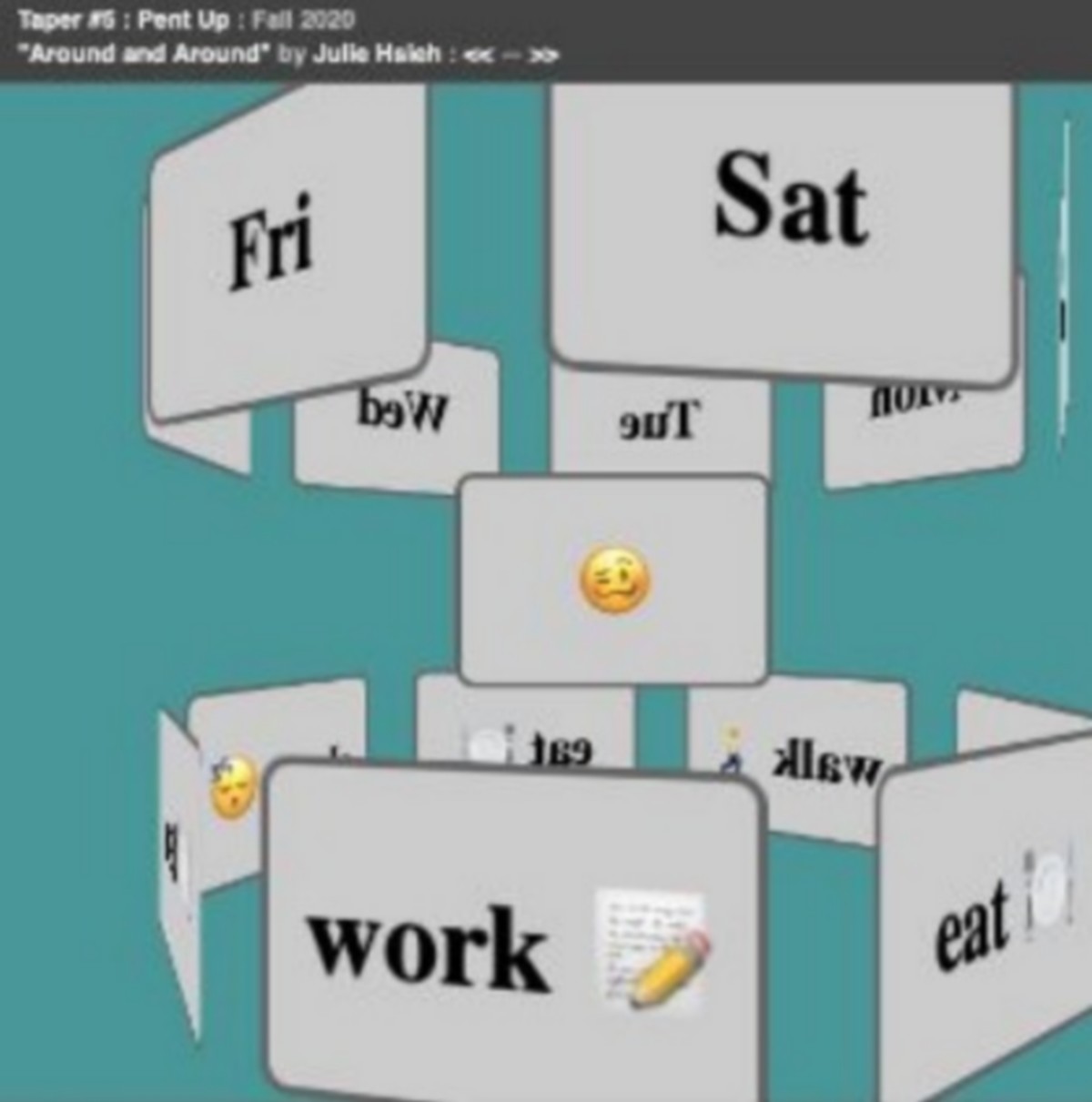
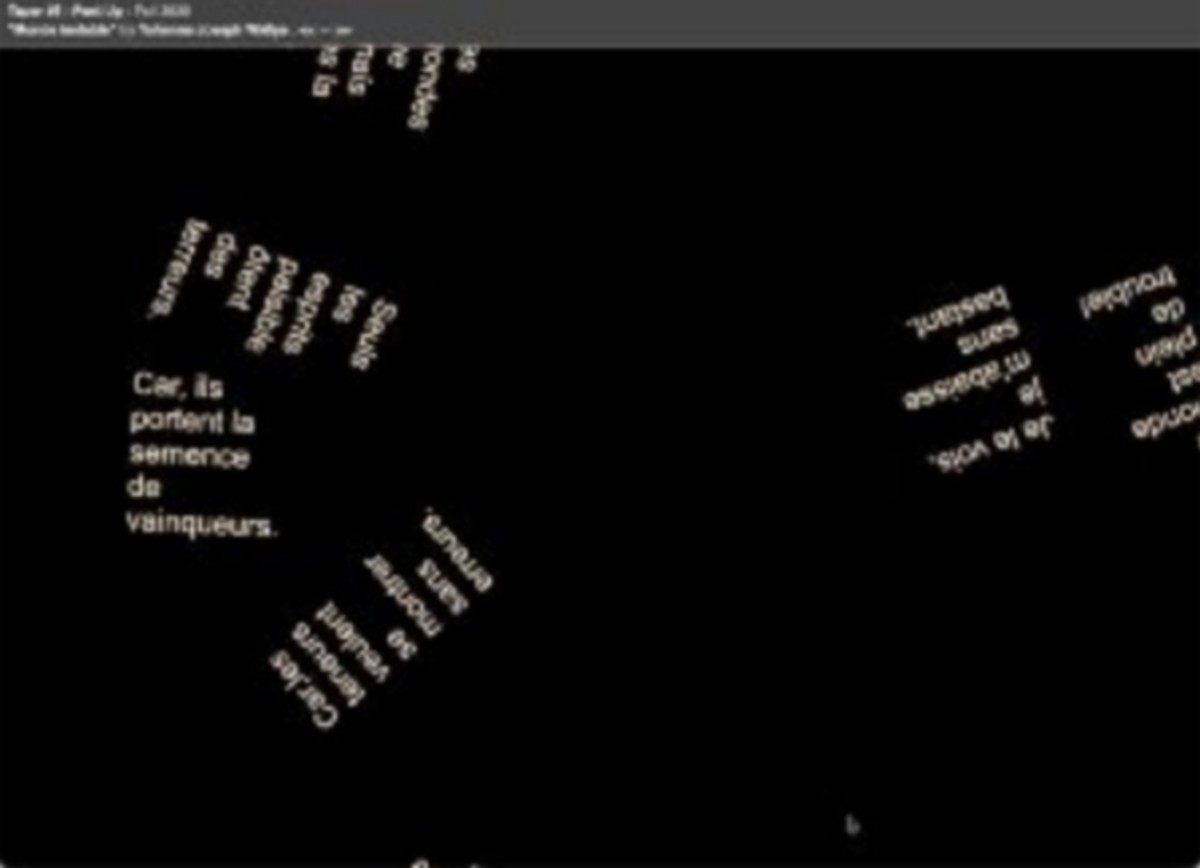
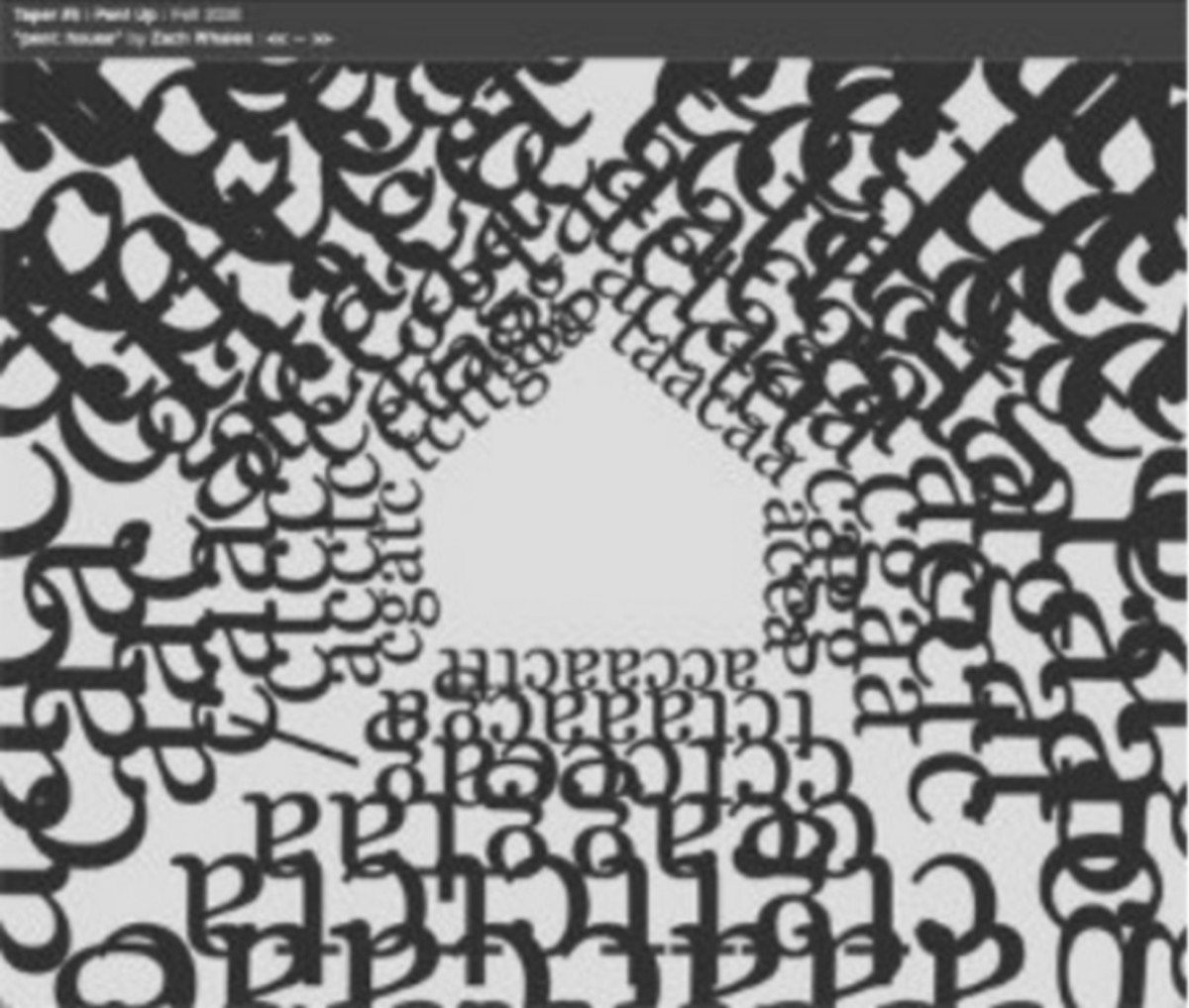
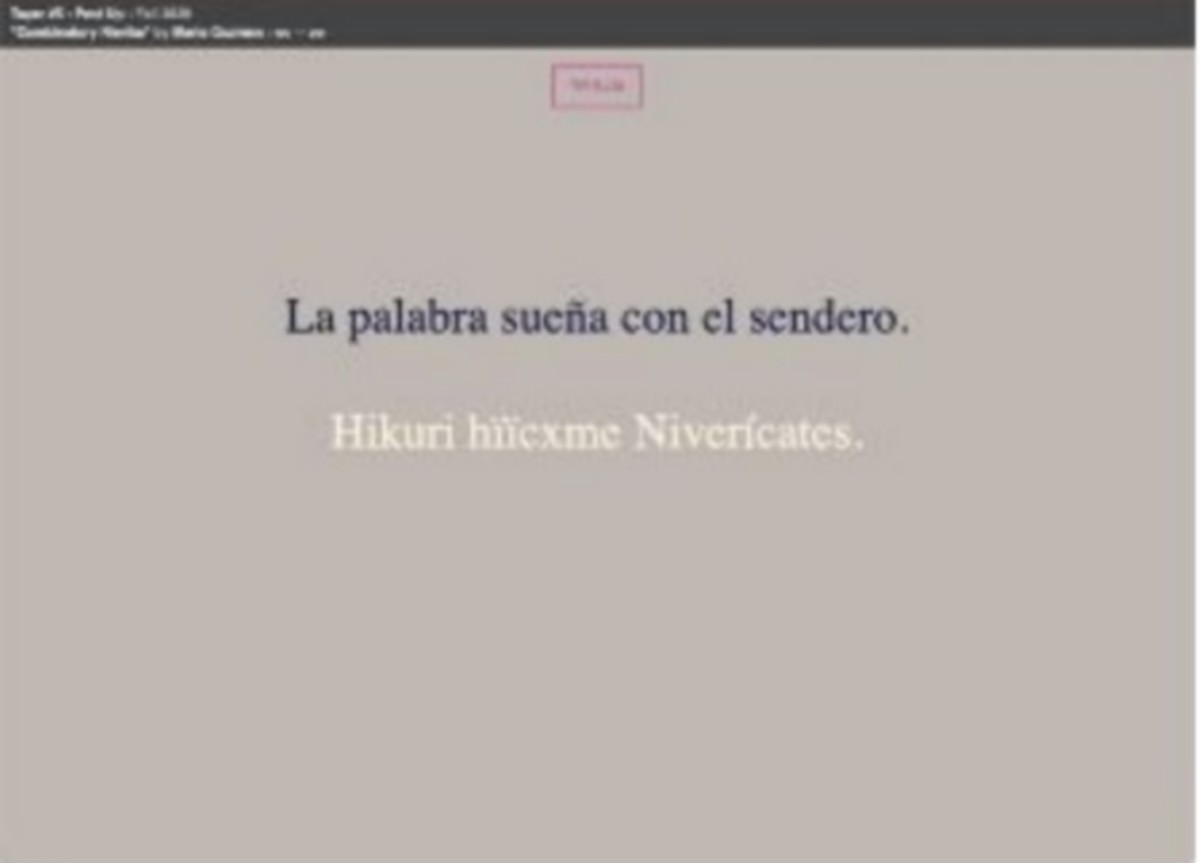
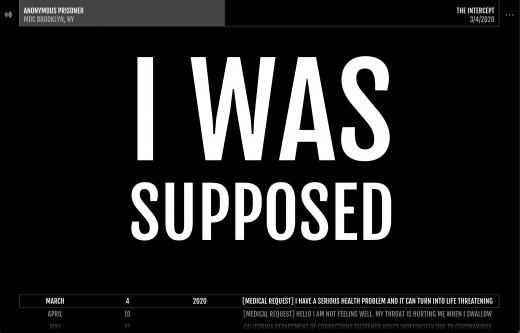
Sharon Daniel + Erik Loyer
EXPOSED
link = EXPOSED
Artwork Description:
EXPOSED reveals the overwhelming scope and scale of this humanitarian crisis.
The monochrome, image-less, headline-styled interface, which allows viewers to step through thousands of prisoners’ statements, is designed to visualize their collective suffering, and signal that the injustices they endure are structural.
EXPOSED applies dynamically generated typographic treatments and performative interaction design to the words of prisoners, detainees, and their families, in order to make the effects of the catastrophic spread of COVID-19 in prisons more accessible to the general public.
This approach is accomplished using an updated version of an algorithm originally developed for Daniel and Loyer's Public Secrets (2007), and is delivered using Stepworks, Loyer's emerging platform for creating "story instruments". In this way, EXPOSED engages the themes of "COVID E-lit" and "Platforms" simultaneously.
Connection to Theme:
The criminal punishment system in the United States confines over two million people in overcrowded, unsanitary, and unsafe environments where they cannot practice social distancing or use hand sanitizer and are regularly subjected to medical malpractice and neglect.
EXPOSED documents the spread of COVID-19, over time, inside these prisons, jails, and detention centers, from the perspective of prisoners, detainees, and their families.
Quotes, audio clips, and statistics collected from a comprehensive array of online publications and broadcasts, are assembled into an interactive timeline that, on each day, offers abundant testimony to the risk and trauma that prisoners experience under coronavirus quarantine.
On July 8th alone, there are over 100 statements included in the interface — statements made by prisoners afflicted with the virus or enduring anxiety, distress, and severe hardship. Unfortunately, their words are all we have. Since the first reported coronavirus infection in the US, incarcerated people have been subjected to extreme forms of isolation — visits have been suspended, phone privileges restricted, and the use of solitary confinement expanded exponentially.
Prisoners are stranded in quarantine without adequate food or medication — abandoned and unseen.
Biography:
Sharon Daniel is a digital media artist who creates interactive and participatory documentary artworks addressing issues of social, racial and environmental injustice, with a particular focus on mass incarceration and the criminal justice system. Documentation of exhibitions and links to her projects can be found at http://sharondaniel.net.
Erik Loyer builds software artworks and creative tools that adapt difficult subjects into stories people can play like instruments. His web and mobile works explore social justice and spirituality while combining elements of comics, video games, and interactive music, and his work has received international recognition in the digital humanities, electronic literature, independent games, and interactive comics fields.
==>> Daniel's Website <<==
==>> Loyer's Website <<==
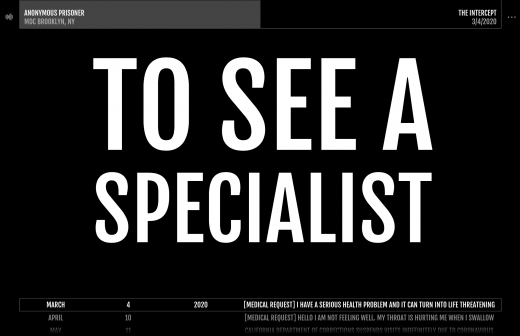


Mark Sample
Content Moderator Sim
link = Content Moderator Sim
Connection to Theme:
Content Moderator Sim connects to the theme of COVID E-Lit in several ways. Written in the midst of the coronavirus shutdowns and George Floyd protests in the summer of 2020 in the United States, the game features several moderation "cases" that involve the pandemic, police brutality, and the increasing power of white nationalists on social media.
The game critiques the role social media platforms have played in contributing to disinformation, conspiracy theories, and intolerance during the past 12 months.
Content Moderator Sim is quite simply about what it means to be online in the third decade of the 21st century.
Artwork Description:
Content Moderator Sim puts you in the role of a subcontractor whose job is to keep your social media platform safe and respectable. Informed by Sara Roberts’ ethnographic research into online content moderation, the game tasks you with either approving or removing social media posts that users have flagged.
Playtime is approximately 5 minutes. Headphones or speakers are recommended.
Content Warning: Brief written references to abuse, self-harm, racism, and brutality, but no images or video.
Biography:
Mark Sample is an Associate Professor and Chair of Digital Studies at Davidson College. His teaching and research focuses on digital culture, electronic literature, and videogames. His is a co-author of 10 PRINT CHR$(205.5+RND(1)); : GOTO 10 (MIT Press), a collaboratively written exploration of creative computing and the Commodore 64.
His most recent work combines creative coding with critiques of digital culture, including the games “Content Moderator Sim” and “10 Lost Boys.”
==>> Artist's Website <<==


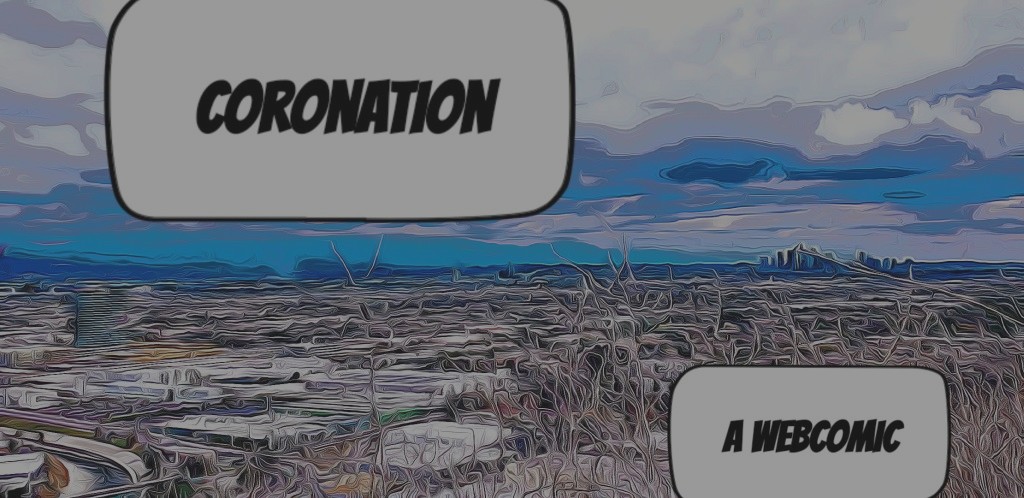
Marino Family
Coronation:
a webcomic
link = Coronation
Connection to Theme:
As the pandemic continues to sweep the globe, Coronation documents one family’s experience of the ups and downs of the Corona virus and the surrounding times, including the 2020 US Election and its ensuing drama and the Black Lives Matter protests.
The comics are profoundly domestic and yet reflective of a global crisis, focusing on intimate family moments, transformed through digital tools into a visual expression of the ongoing homestay during a time of turmoil. As we craft these together, the webcomic has been a way for our family to take this time of chaos and to respond creatively and collaboratively by reflecting on the life in one household. We try to frame our experience with humor, sensitivity, and a medicine that is in quite short supply, hope.
Unlike previous pandemics, such as polio, HIV, and the Spanish flu, COVID-19 has emerged at a moment of tremendous digital connectivity. However, the news and social media feeds have created so-called doom scrolling. We have used the digital tools and platforms available to us to rapidly document events, to transform them into comics, and to share them online with a broader world, inviting them into our homestay as we share our climbs and falls, confusion and epiphanies, all born of some unexpected family time.
Although our main platforms for distribution are electronic, we have also been producing individual hand-made print versions as well.
Artwork Description:
Coronation is a webcomic created by the Marino family using digital tools and platforms to document our experience of the COVID-19 Pandemic.
Since the beginning of the lockdown and the various homestay orders in Los Angeles, we have been creating and publishing one comic per day, five days a week, using a combination of digital tools, specifically filters and graphics applications.
Images include photographs from our family albums, screenshots and downloads from Internet-based news sources, as well as original hand-drawn images created using digital tools.
Biography:
The Marino Family have been making digital literature together since 2013 when they launched their series Mrs. Wobbles & the Tangerine House, an ongoing collection of interactive tales set in a magical foster care home. (http://markcmarino.com/mrsw/) For the past year, they have been more or less in homestay, spending more time together than most families with teenagers would dare.
In addition to their digital works, the family also makes card games, sourdough bread, and homemade decorations. Not to mention mischief.
The Marinos want to say, “Our hearts go out to everyone who has lost a loved one or suffered from the isolation and deprivation of this pandemic.”
==>> Artist's Website <<==
Artwork Images
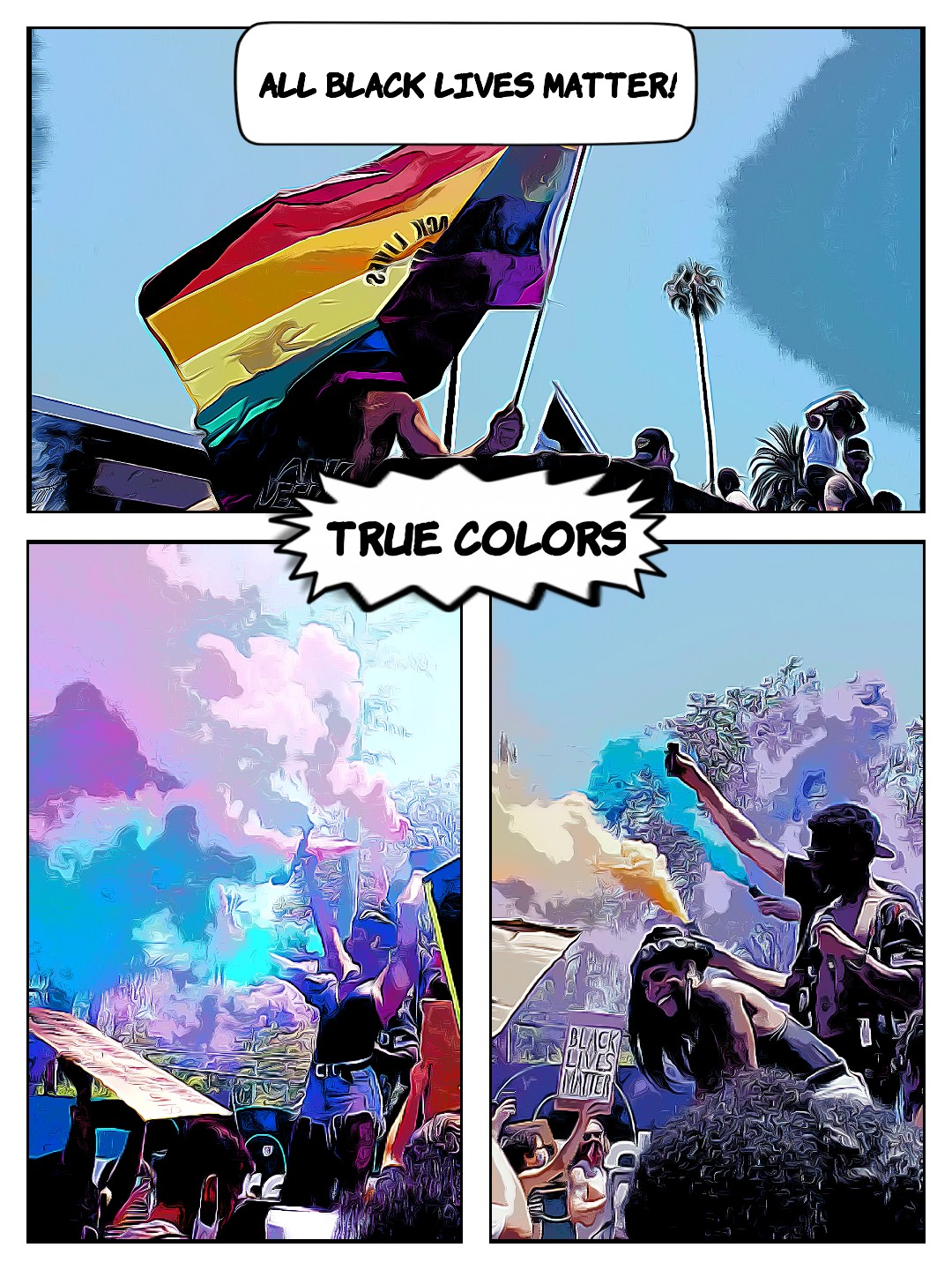
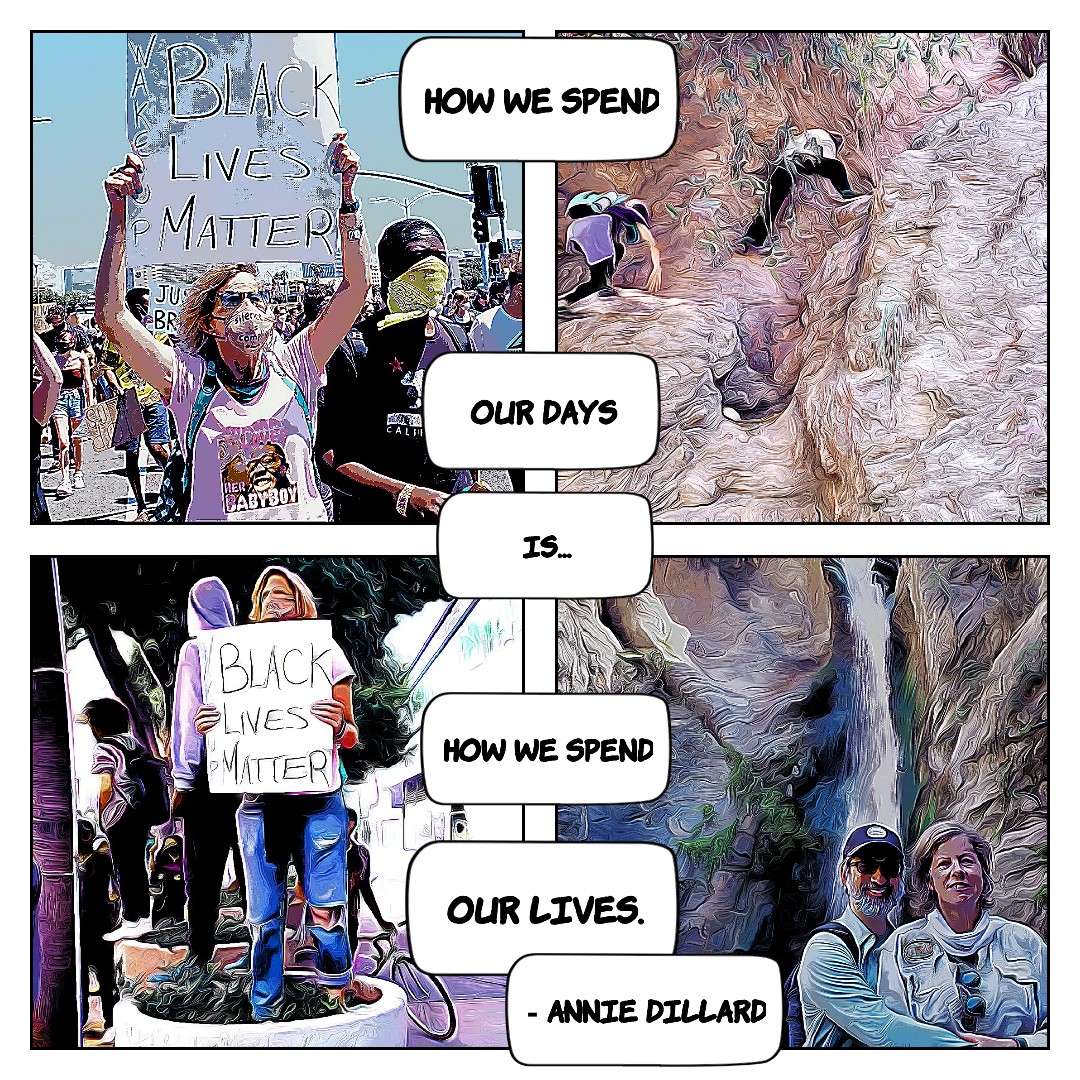
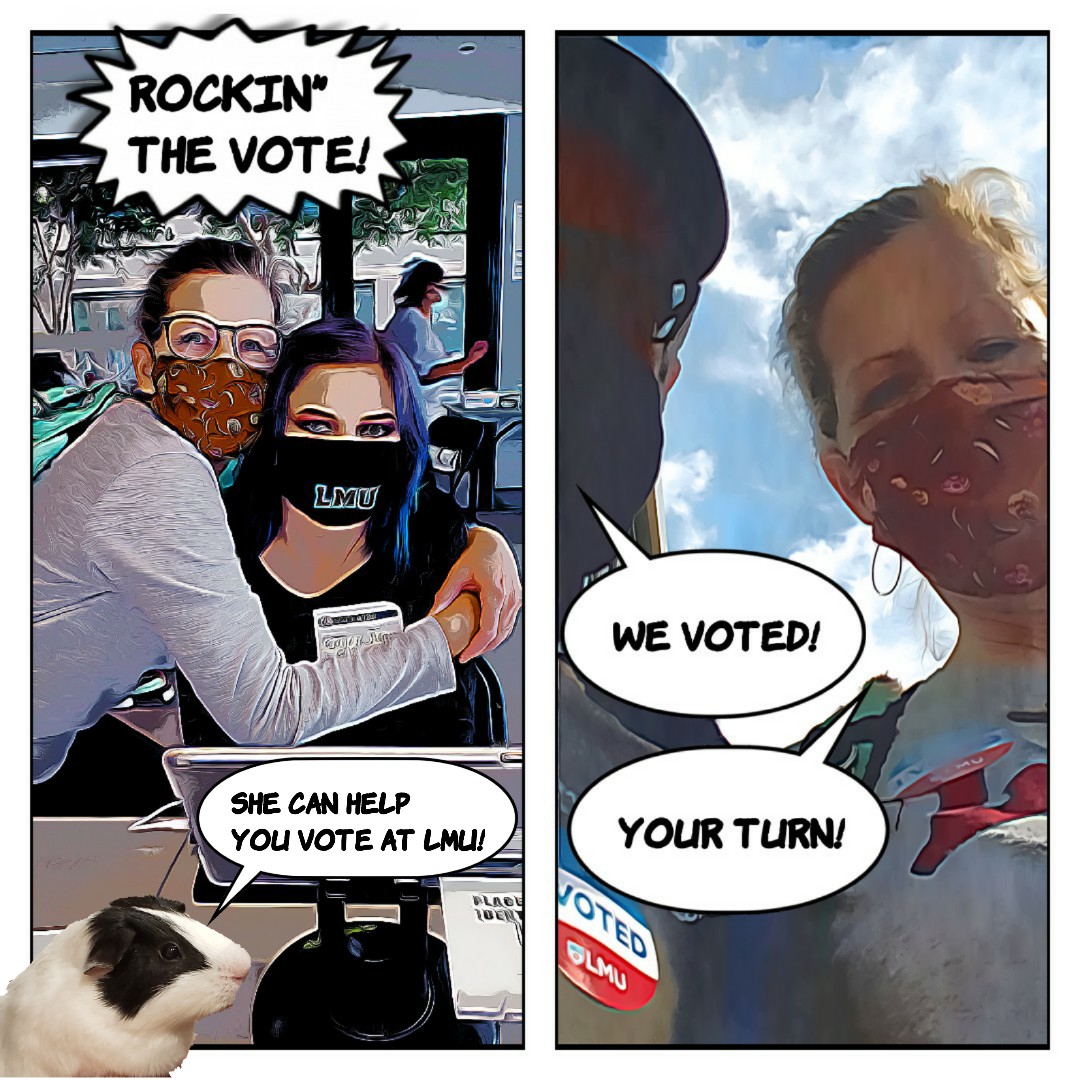

Xtine Burrough
I Got Up 2020, Pandemic Edition
link = I Got Up 2020, Pandemic Edition
Connection to Theme:
Made during the pandemic, these daily vignettes interpret “getting up” as unusually labor intensive—creative on the best days and merely possible on the worst. As a result of my the quarantine, and the collapse of professional and domestic spaces, this series of getting up is a creative family adventure.
Artwork Description:
I Got Up 2020, Pandemic Edition started as an Instagram series inspired by On Kawara’s 1968-79 daily postcard ritual. This version of I Got Up 2020, Pandemic Edition showcases moving images made during the summer of 2020. From 1968-1979 On Kawara sent picture postcards to two friends, stamped with the time he “got up.”
His series, I Got Up, is collected by the Metropolitan Museum of Art. This riff on I Got Up is a visible record of getting up while confined to the house and simultaneously enacting the roles of mother, artist, housekeeper, and teacher.
The Met website suggests, “With tremendous economy of means and a surprising visual elegance, Kawara creates a complex meditation on time, existence, and the relationship between art and life.”
Biography:
Xtine Burrough is a hybrid artist.She uses remix and appropriation as a strategy for engaging networked audiences in critical participation at the intersection of media art and digital poetry. A Professor and Area Head of Design + Creative Practice in the School of Arts, Technology, and Emerging Communication at UT Dallas, burrough is the Creative Director of LabSynthE, a laboratory for the creative investigation of synthetic and electronic poetry.
==>> Artist's Website <<==


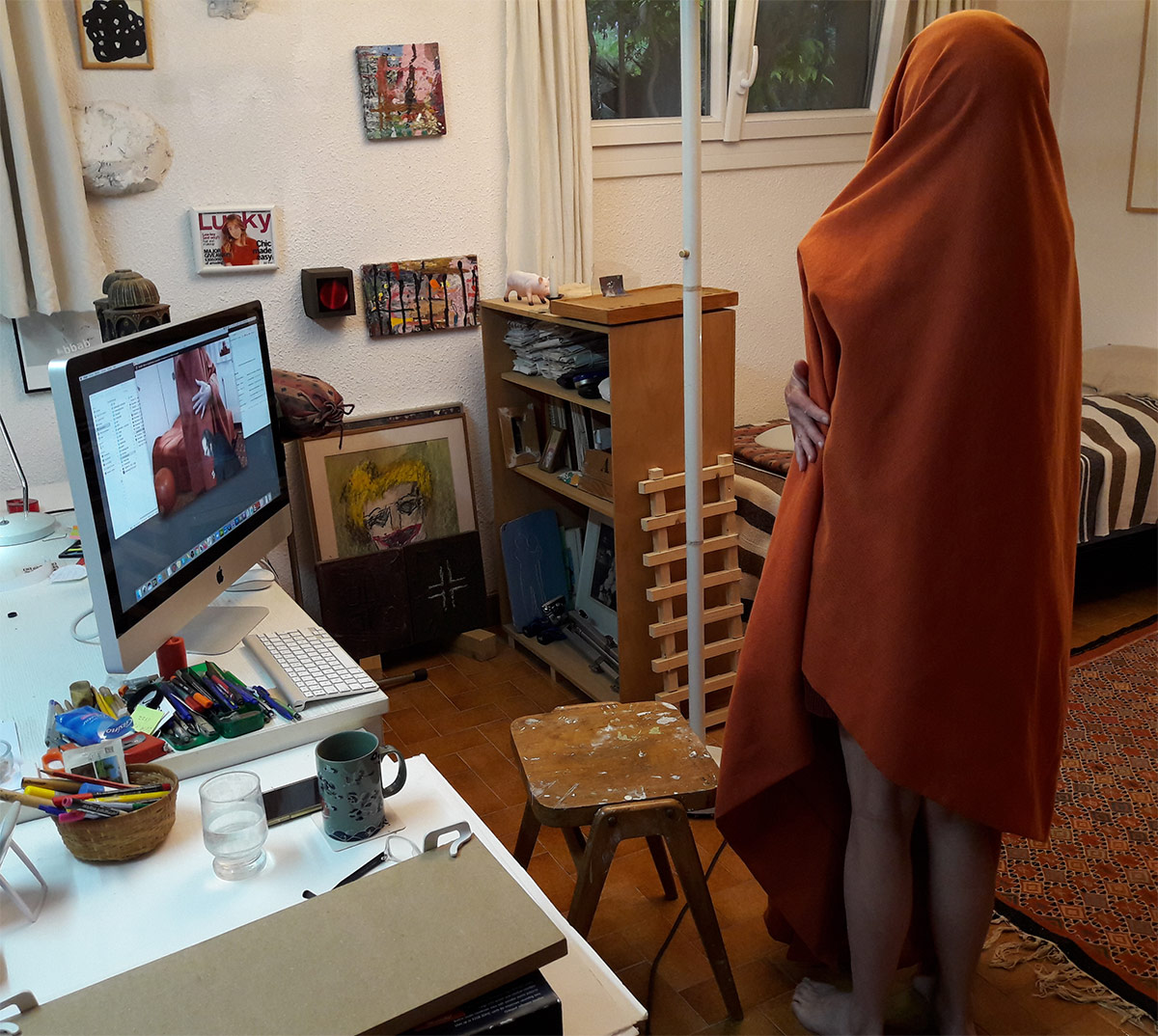
Annie Abrahams
Pandemic Encounter
link = Pandemic Encounter
Connection to Theme:
Breathing is a common usually unconsious process shared by all. During COVID times, for some, it became suddenly a source of anxiety. I was one of these.
The sound piece Pandemic Encounter is meant to exteriorate the disconfort of this raw and raspy reality in a “song” where personal respirations mix with computer generated distorted heart beats and a, by twenty artists from all over the world recorded, silence.
Artwork Description:
In Pandemic Encounter, Annie Abrahams mixed her respirations with computer generated distorted heart beats and extracts from "Silences" by Frans van Lent.
Biography:
Annie Abrahams is based in Montpellier, France. She has an art practice that meanders between research and performance. Her carefully scripted art tends to reveal ordinary human behaviour and develop what she calls an ‘aesthetics of trust and attention’.
Abrahams is interested in collaborative practices as a learning place for a “being with”. She is known worldwide for her netart (Being Human – online low tech mood mutators / not immersive. 1996 – 2007), collective writing experiments and is an internationally regarded pioneer of networked performance art.
==>> Artist's Website <<==
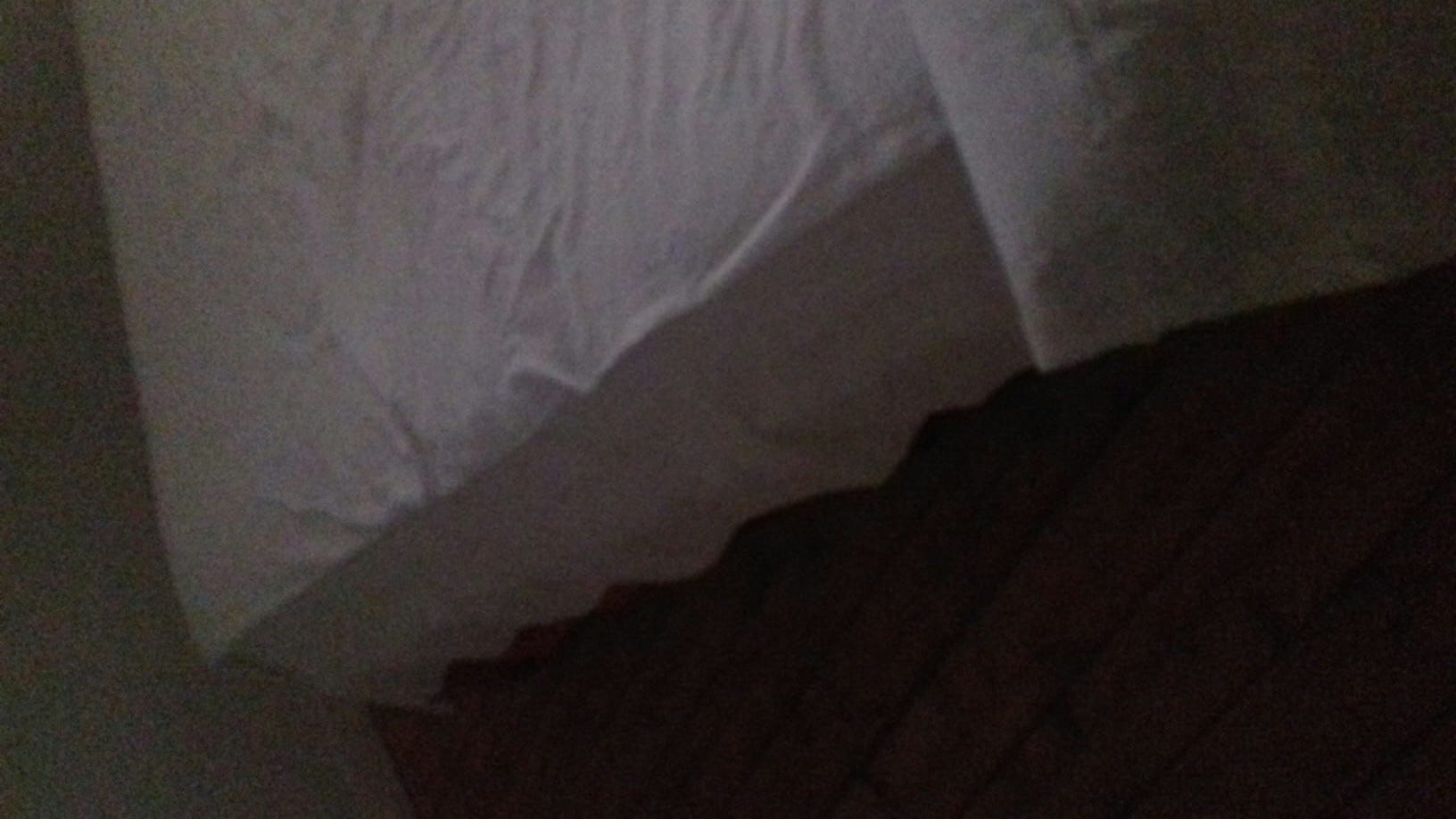
photo by Sally Annett
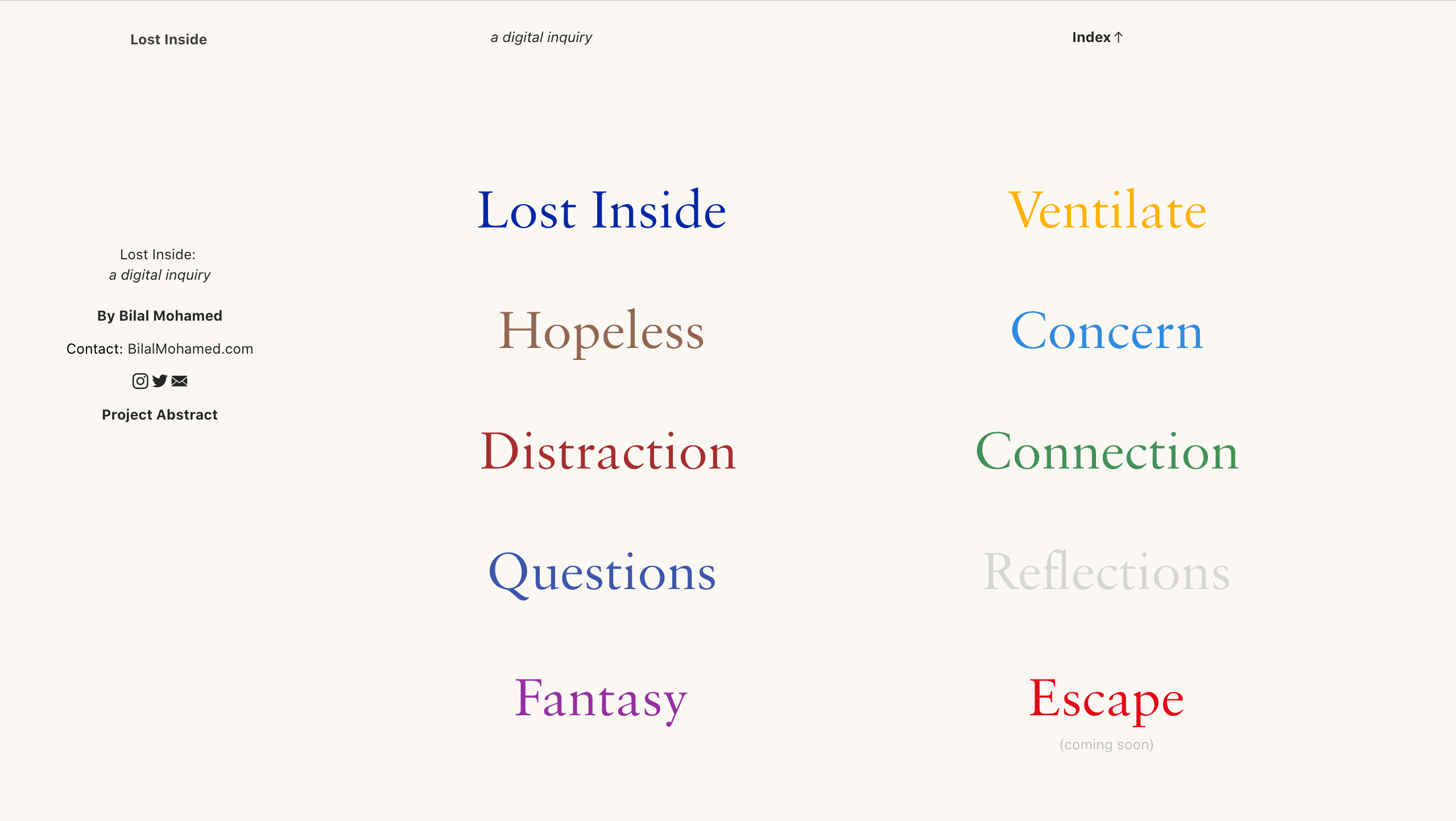
Bilal Mohamed
Lost Inside:
A Digital Inquiry
link = Lost Inside
Connection to Theme:
While it does not necessarily comment on politics and the status of the pandemic, except slightly, it mainly highlights the states/stages, metaphysically and emotionally speaking, which we as individuals tend to undergo due to the circumstances COVID has provided us.
These stages, such as hopelessness, concern, distraction, connection, fantasy, reflection, and questioning, are expressed in the journal through images, text, drawings, audio, and video accumulated during the period itself.
While it is mainly told through a perspective that is personal and from a character who is largely based on my person, or explicitly "me", the author, I believe the musings of this work are largely prolific and universal in the emotions and viewpoints they present. The journal is prone to updates and additions, as the theme is based on COVID, therefore as long as the virus persists, the digital journal will as well.
Artwork Description:
Lost Inside: A Digital Inquiry is a COVID-era digital journal inspired by J.R Carpenter's "Entre Ville" that assumes depths of hypertext, intimate entries, and personal and visual perspectives that highlight a state of stasis due to the quietude and uncertainty of the outer world.
The purpose of this work is to create an intimate space for rumination on the experience of life under quarantine and a pandemic.
Biography:
Bilal Mohamed is a Muslim-Oromo writer, artist, and curator.
His projects include short-films, (award-winning) radio horror, photography, art direction, and modeling. He currently hosts the podcast Writer on the Run where he discusses art and life with his artist friends, and is publishing two books: I’m Here and I’m Not, an essay and photo collection on his travels in Cambodia, and Aşkim, a photo book documenting beauty and happenings in Istanbul, Turkey, both to be available in 2021.
==>> Artist's Website <<==
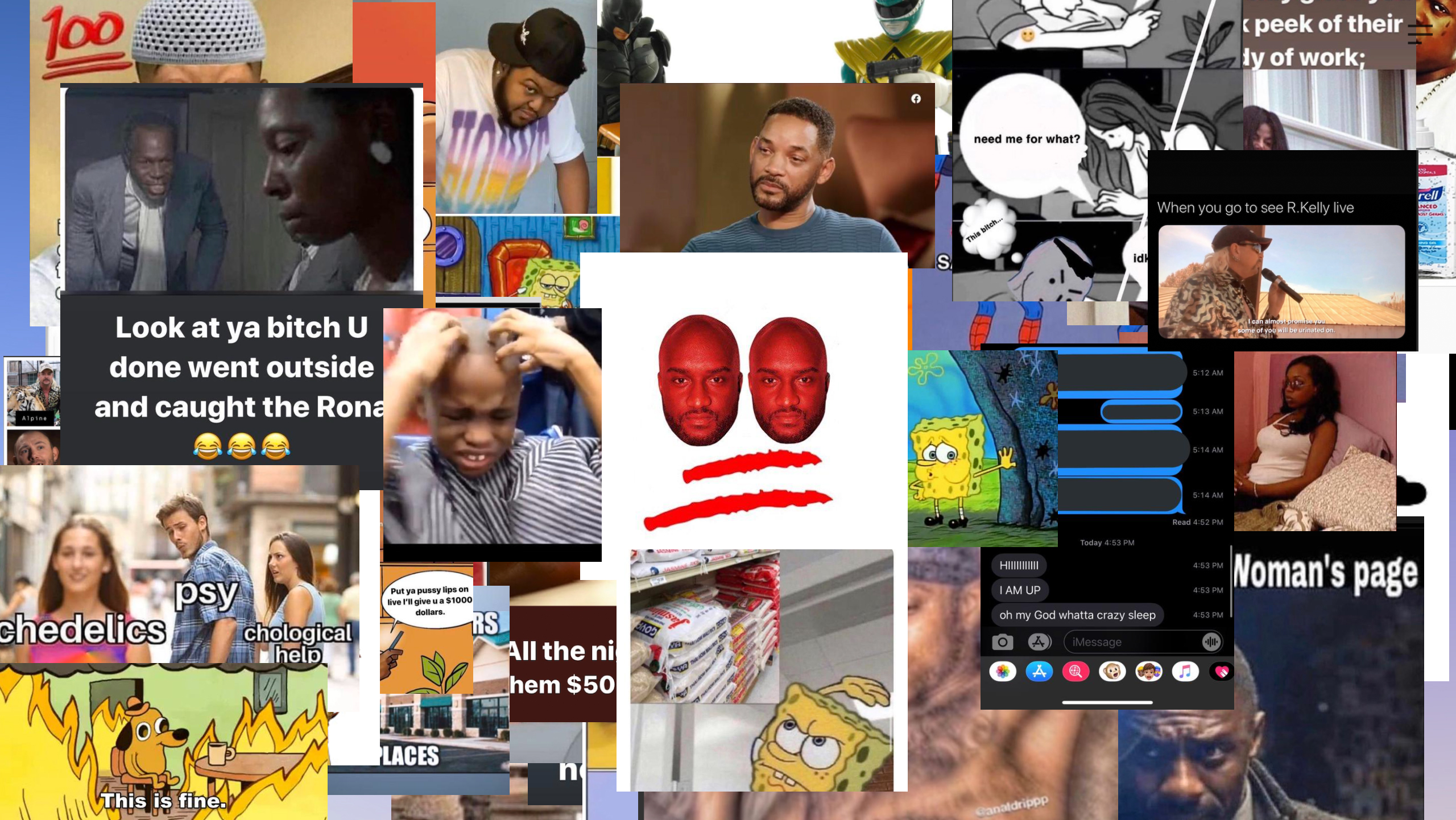

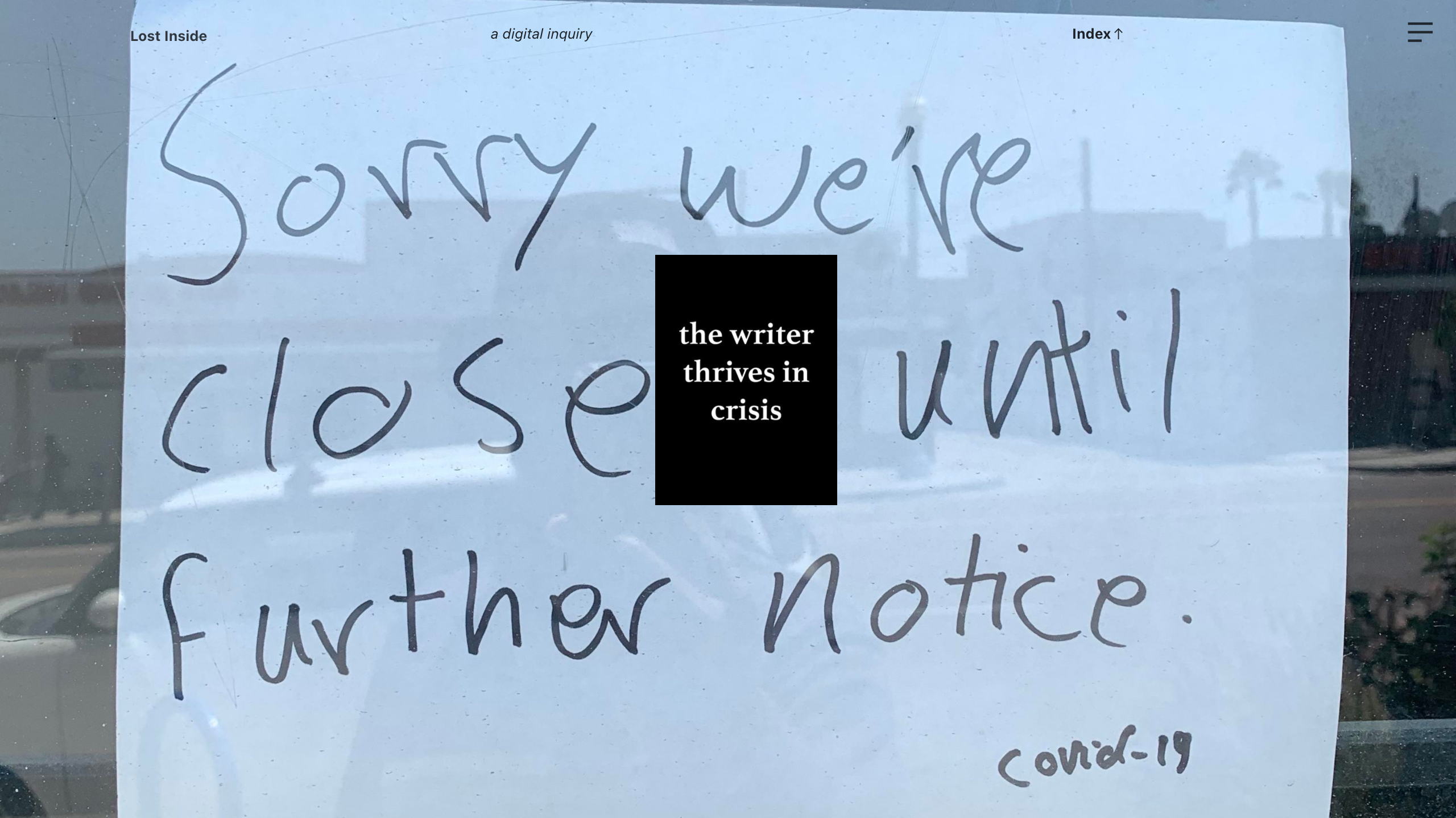


Amaranth Borsuk
Curt Curtal Sonnet Corona
link= Curt Curtal Sonnet Corona
Connection to Theme:
Artwork Description:
In March 2020, at the start of the COVID-19 pandemic, Nick Montfort published “Sonnet Corona,” a tiny program that can generate a crown of 3^14 or 4,782,969 potential sonnets. Its 14 monometer lines evoke the enclosure and uncertainty of the early lockdown.
Curt Curtal Sonnet Corona utilizes Montfort’s code to generate 4^11 or 4,194,304 curtal, 11-line sonnets with 4 variables per line. The abbreviated form felt appropriate to my feelings about this moment at the end of a very difficult year, but one illuminated by hope, as my son, due in January 2021, decided he couldn’t wait and joined our family in the final weeks of December.
Curt Curtal Sonnet Corona is dedicated to Dorothea and Dashiell.
Biography:
Amaranth Borsuk is a poet, scholar, and book artist whose work encompasses print and digital media, performance and installation. She received an NEA "Expanded Artists' Books" grant for the collaboration Abra, a limited-edition book and free iPad and iPhone app that received the Turn on Literature prize for electronic literature.
She has collaborated on installations, art bookmarklets, and interactive works, and is the author of five books of poetry, including Between Page and Screen (Siglio Press, 2012), augmented reality poems created with Brad Bouse.
Other digital collaborations include The Deletionist, an erasure bookmarklet created with Nick Montfort and Jesper Juul; and Whispering Galleries, a LeapMotion interactive textwork commissioned by Site Projects for the New Haven Free Public Libraries.
Amaranth is currently Associate Professor of Interdisciplinary Arts and Sciences at the University of Washington, Bothell, where she also serves as Associate Director of the MFA in Creative Writing and Poetics.
==>> Artist's Website <<==
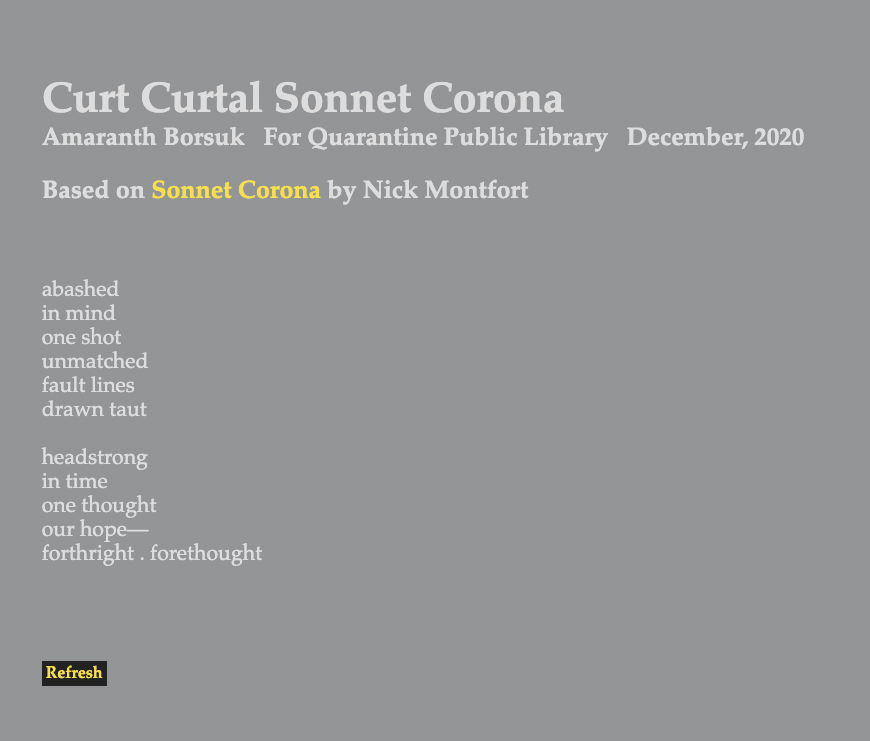

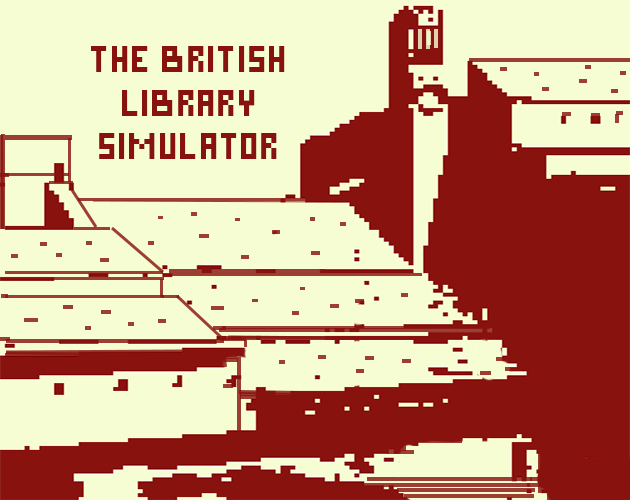
Giulia Carla Rossi
The British Library Simulator
link = The British Library Simulator
Connection to Theme:
The British Library Simulator is a short browser-based game created by Giulia Carla Rossi during the 2020 lockdown using Bitsy, a free game engine developed by Adam Ledoux.
It was published online in June 2020, while the Library buildings were closed.
The British Library Simulator was created as a fun way to engage with our audience during the pandemic, giving them a chance to visit a different version of the Library, while learning interesting facts about the physical building and the Library as a whole. It was also a way to make the public aware of the services we continued to provide even during lockdown, by highlighting ongoing projects and the digital content that could be accessed from home (such as the Sound Archive and the UK Web Archive).
Finally, it provided an example of the digital interactive narratives we are collecting as part of our work on emerging formats and new digital media.
Artwork Description:
The British Library Simulator aimed to present libraries under a different light: not just as keepers of knowledge, but also as creators of content willing to engage with new technologies, even during a time of crisis. In the game, players wander around the St Pancras building in London, encountering different characters (other visitors and members of staff) on their way to the Reading Room.
The game takes less than 10 minutes to complete and the gameplay is deliberately limited (the only obstacle players need to overcome is leaving their belongings at the Cloakroom before entering the Reading Room). This choice was made in an effort to make the game appealing and accessible to a wider audience, including people that don’t necessarily identify as gamers, and to keep the main focus on the information relative to the British Library and its services.
Biography:
The British Library Simulator was created by Giulia Carla Rossi, the British Library’s Curator for Digital Publications.She is responsible for supporting the Library in developing capacity to manage collections of complex digital objects as part of the Emerging Formats Project.
Currently, the project is focusing on publications produced for mobile devices (apps) and interactive narratives, covering requirements across the collection management lifecycle. She’s in the process of curating an online collection of all shortlisted and winning entries to the New Media Writing Prize, to be hosted on the UK Web Archive. She is interested in interactive storytelling, net art and how new technologies and forms of creating and consuming content are challenging existing practices in collecting institutions.
==>> Artist's Website <<==
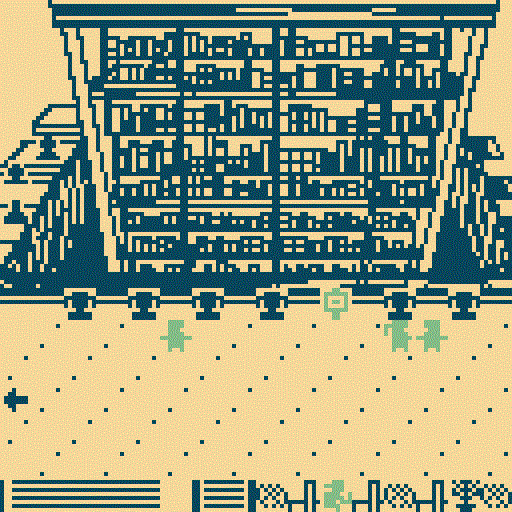
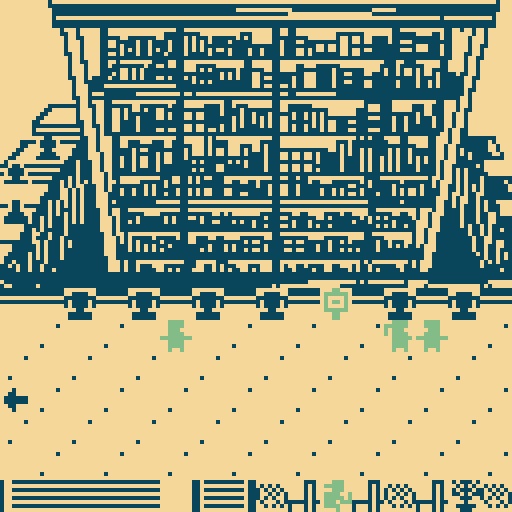

Lissa Holloway-Attaway
Jamie Fawcus
PATTER(n)INGS: Apt. 3B
link =PATTER(n)INGS: Apt. 3B
NOTE: PSSWRD is Patt2020
Connection to Theme:
In our piece we explore themes of intimacy, proximity, disruption and mediation through our audio-only documentation of suspended being(s) in the emerging and familiar spaces, patterns and troubled times of contemporary 2020 COVID existence inside the many rooms of Apt. 3B (wherever that is).
We draw creative inspiration from personal historical accounts of plague and disease narratives (Boccaccio’s Decameron, Pepys’ Diary of Samuel Pepys, Gilman’s “The Yellow Wallpaper,” for example), as well as reflections on home and storytelling (from Ursula K. LeGuin and others), combined with original texts, recordings and contemporary (2020) news reporting focused on global destruction, recovery, resistance, and homage.
We remix, re-design and (sound) engineer an audio experience deliberately intended to evoke curiosity from eavesdropper-users, drawing them in, while distancing them through confusion and discomfort.
Artwork Description:
Our interactive audio experience moves between deep materiality and immaterial illusion, and it is captured through spatial dis/orientation, fragmentation, layered affects, embodied response, and confession, all reconstructed by a single eavesdropper-user, also ideally in semi-isolation.
Created as a web-based interface (but with downloadable versions for PC and MAC available), and with no identifiable graphics, other than a full-screen black square, the eavesdropper-user wears headphones (and ideally a face mask, blindfold, or plague doctor hood, if available) and may only move a computer mouse blindly across the flat surface of a desk in front of the blackened computer monitor. Hidden sound files, which also move and shift, must be discovered by the eavesdropper-user, who accesses them through a further limited sense of human touch, mediated through the mouse.
The sound files shift and are layered to create the manifold and multiplicitous spaces (‘rooms’) of “Apt. 3B,” both a site-specific—and therefore bounded location—but also a conceptual space of endless limitation and resonance. (Left mouse clicks allow users to move from room to room, signaled by opening/closing door creaks, and right clicks allow escape.)
Biography:
Lissa Holloway-Attaway (PhD) is an Associate Professor in Media Arts, Aesthetics, and Narration where she teaches in the Division of Game Development at the University of Skövde, Sweden. She is the leader of the Media, Technology and Culture (MTEC) research group where she focuses on transdisciplinary and transhistorical media across many genres and forms. Her current research is focused on emergent media (AR/VR/MR), cultural heritage games, and experimental narrative within interactive digital media and art. Her work has been exhibited, performed and published in many International venues and contexts.
Jamie Fawcus (PhD) is a composer, sound designer and performer. His interests centre on the language of physical space in acousmatic art, location-specific performances and sound assembly, archaeoacoustics, and EAM. Jamie is currently Senior Lecturer in electronic music and sound design/production in the Division of Game Development at the University of Skövde, Sweden.
==>> Artist's Website <<==
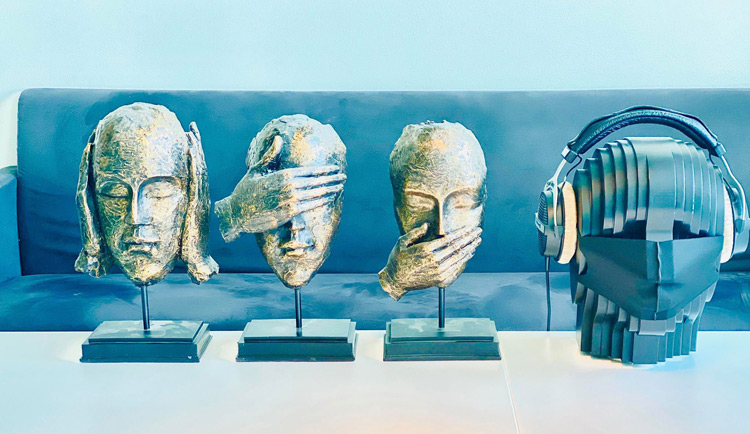


Diogo Marques+
João Santa Cruz+
Daniela Reis
RE\VERSE: an elegiac e-poem
link =RE\VERSE: an elegiac e-poem
Connection to Theme:
RE\VERSE: an elegiac e-poem (2020-21) results from the collaboration between cyberliterary artist collective wr3ad1ng d1g1t5 and visual artist Daniela Reis during the first 40 days after the Covid-19 pandemic status (March – April 2020). Following a random plus (pre-)combinatorial logic, 40 textual verses and 40 pictorial fragments intertwine in order to provoke a self-reflective reading of the verse(s) and reverse(s) characterizing the first quarantine period of pandemic confinement by COVID-19.
On one side, a painter making use of the sparse materials she had at home, locked up in a small apartment and without access to her studio, dividing her attention between two children, a husband and a dog; on the other side a poet ekphrastically writing a verse per day as suspended portraits of a collective experience of fear, uncertainty, and emptiness that assaulted the whole world. Combined, in the sum of their verses and reverses, image and text (un)veil a dialogic path that, although necessarily entropic, is made of continuous renewal.
Serving as a potential and fractal portrait of what it means/meant to be artistically active/creative during one of the most restrictive and impactful periods of the COVID-19 pandemic so far, RE\VERSE: an elegiac e-poem (2020-21) multimodally reflects the experience of quarantine by each one of its participating authors (wr3ad1ng d1g1t5 cyberliterary collective in collaboration with visual artist Daniela Reis), but also, and perhaps more importantly, their perceptual representations from a collective experience of fear and uncertainty during confinement.
Having as its visual/digital interface the verse and reverse of a card off the deck, the e-poem makes use of the concept of play/game in order to self reflexively re-present ebb and flow between order and disorder experienced during the current pandemic. As such, despite its elegiac nature (its textual component subverts traditional structure of a classic elegy by making use of heptameters), RE\VERSE is intended to symbolically disrupt a logic of contamination, and consequently reveal the transmission chain of another type of infection: that of benign artistic expression and collaboration.
Artwork Description:
RE\VERSE: an elegiac e-poem (2020-21) results from the collaboration between cyberliterary artist collective wr3ad1ng d1g1t5 (Diogo Marques / João Santa Cruz) and visual artist Daniela Reis during the first 40 days after the Covid-19 pandemic status (March – April 2020). Following a random plus (pre-)combinatorial logic, 40 textual verses and 40 pictorial fragments intertwine in order to provoke a self-reflexive reading of the verse(s) and reverse(s) characterizing the experience of confinement. Combined, image and text (un)veil a dialogic path that, although necessarily entropic, is made of continuous renewal.
Biography:
Diogo Marques (Ph.D. in the Materialities of Literature, 2018, University of Coimbra) is author of digital literature, curator of new media arts and translator of digital interactive fiction to Portuguese language. His current lines of interest focus on the confluence of artistic and scientific research, at the interstices of the holy triad “art, science and technology”. He is a founding member of Portuguese artist collective wr3ad1ng d1g1t5 (www.wreading-digits.com).
João Santa Cruz: Software Engineer, double daddy, musician, farmer and carpenter apprentice. Developing user experiences for +15 years now, JSC started by creating intranet browser applications. Searching for larger scale projects, moved to large scale development where seriously learned about web while the technology itself was growing. Went from static to full administrable, intranet and public websites, front/back-end applications, web-services, widgets, integrations, documentation, e-commerce and forums. Back in 2007, while exploring the web environment, JSC had built his own collection of tools, this is the framework he uses when developing his personal projects. Later, the passion to deliver content and features to the user, lead him to study about mobile platforms. After a four year period as a full-time mobile applications developer, JSC started to search for the next step. Freelance was the way. Since then he is working every day to find creative ways to deal with real life challenges.
Daniela Reis is a full time painter, art teacher, art mediator, mother of two wonderful kids and a dog. Has done several individual and collective exhibitions in Portugal and abroad, works with theater props, building scenarios, and digital painting. She is engaged with personal projects and commissioned work in her studio. Her pictorial practice is based on curiosity and pleasure, considering the body as a central subject. She is a Master of Fine Arts in Painting, University of Lisbon’s Faculty of Fine Arts; has a University Degree in Painting, University of Lisbon, Faculty of Fine Arts and a Post-Graduation in Leadership Training and Team Development in ISPA (Institute of Applied Psychology).
==>> João Santa Cruz Website
==>> Diogo Marques Website
==>> Daniela Reis Website
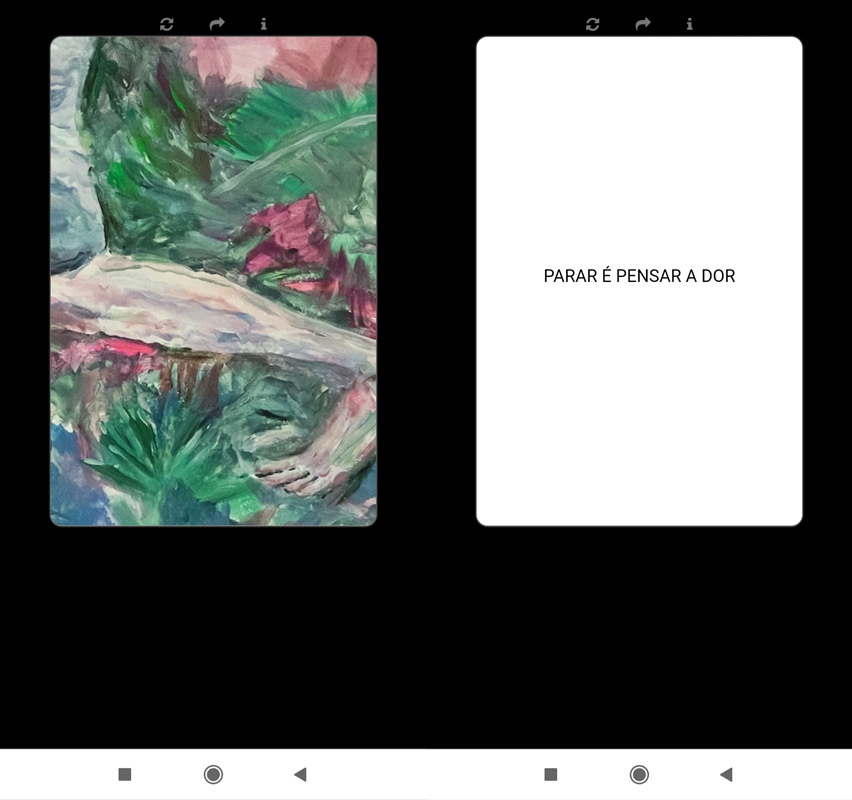

Andanconnerdercu Utterings
Breathing
link = Breathing
Connection to Theme:
Breathing confronts the viewer with a “being” that is the result of an intricate active interlaced communicative structure in which both humans and machines are involved in a process of shared auditory exchange and attention.
Artwork Description:
Breathing, video, 10 min.
Based on Utterings' recorded live performance of the same title during the STWST48x6 MORE LESS festival in Linz Austria. Edited by Daniel Pinheiro.
In this video through the mixing of six audio and video streams emerges an image of a phantomatic breathing, pulsing entity. An entity that thrives through affection, attention, glitches, delays and even voids in a connected environment mediated by machines, cables and compression algorithms.
Biography:
In Utterings, six artists from very different backgrounds gather online and, while blindfolded, engage in a collaborative attempt to go beyond the borders and closures created by languages, opening up and transgressing them in a performance that probes meaning through pre-verbal communication and formerly un-inhabited expressions.
Utterings is a networked performance and research group, an online “band” composed of Annie Abrahams (FR), Daniel Pinheiro (PT), Constança Carvalho Homem (PT), Curt Cloninger (US), Nerina Cocchi (BE) and Derek Piotr (US).
Since its inception in January 2020 Utterings presented 8 online performances of different durations (20min – 2 hours) in different venues: APO-33, Nantes, FR; the Network Music Festival, UK; STWST48x6 MORE LESS, Linz, AT and on We're All Bats Listening Arts Channel, UK. In 2021 they are invited by We're All Bats to lead three workshops. More on the individual artists here https://utterings.hotglue.me/?who
==>> Artist's Website <<==

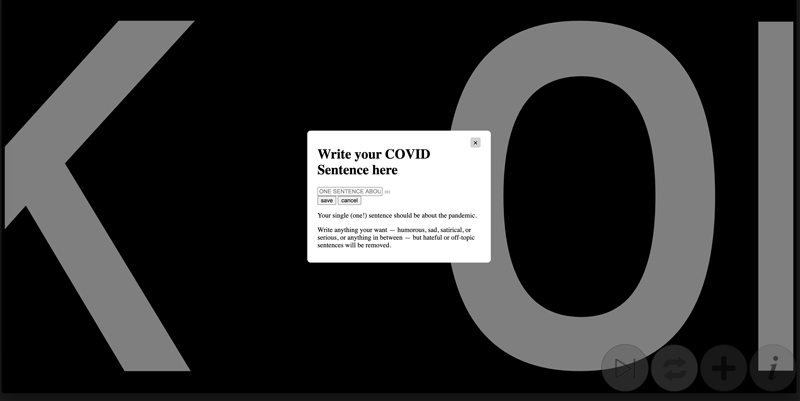
Alan Bigelow
Sentenced to Covid:
Voices of the Pandemic
link = Sentenced to Covid
Connection to Theme:
Sentenced to Covid: Voices of the Pandemic displays our single-sentence responses to the pandemic.
You can read the responses in either manual or auto mode (the latter which provides an endless looping display of the responses).
If you want, you can write your own response for others to see.
Artwork Description:
Sentenced to Covid: Voices of the Pandemic displays our single-sentence responses to the pandemic.
You can read the responses in either manual or auto mode (the latter which provides an endless looping display of the responses).
If you want, you can write your own response for others to see.
Biography:
Alan Bigelow's work, installations, and conversations concerning digital fiction and poetry have appeared in many places worldwide.
You can find his work at webyarns.com.
==>> Artist's Website <<==

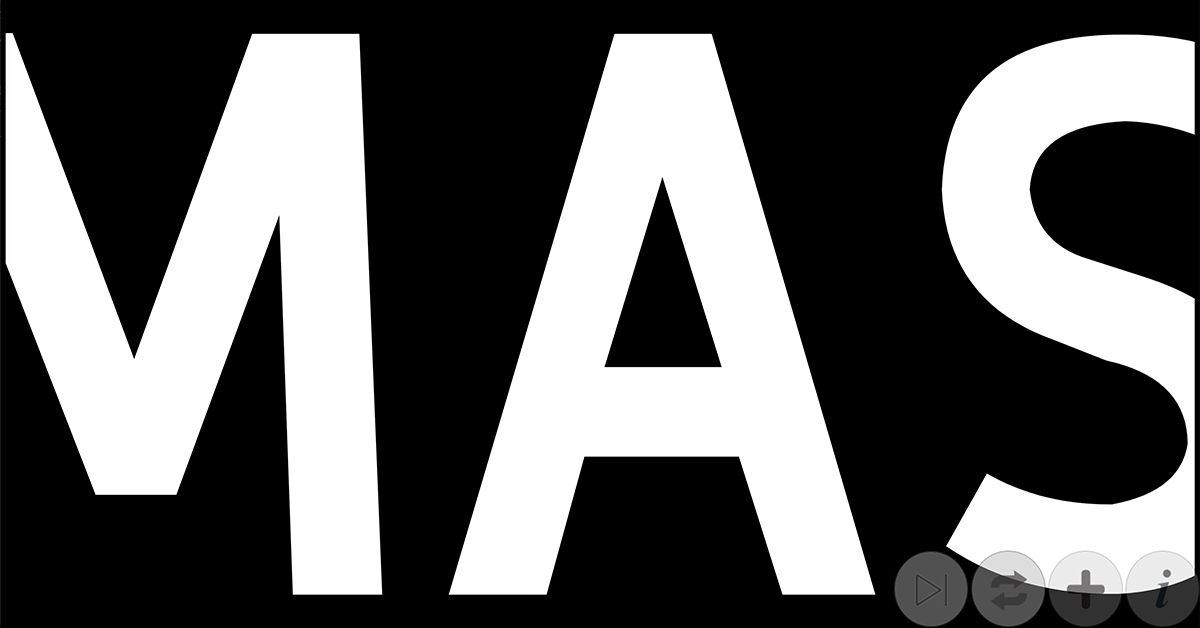

Giselle Beiguelman
Coronário / Coronary
link= Coronário / Coronary
Connection to Theme:
Coronary is a net art project, in the form of a hypertextual essay about the cultural experience of the coronavirus, with emphasis on Brazilian daily life.
Due to negationism of the pandemic, by President Bolsonaro, in Brazil it gains particular features, while maintaining a dialogue with the globalized world.
In this work we approach the phenomenon from three different viewpoints: language, Google mediation, and the aesthetics of surveillance.
Artwork Description:
The Coronary's starting point is a set of 25 words, popular in the context of Covid-19, such as Zoom, alcohol gel, and pandemic, for which we offer a small glossary.
A heat map dynamically checks the audience’s attention regarding the words we listed in the coronavirus lexicon.
The most accessed by the audience change their color on a scale that varies from blue (cooler) to red (hotter and, therefore, more accessed). These heat maps have become recurrent images in the context of Covid-19. They are key images in the pandemic context.
Coronary appropriates the visual vocabulary of the coronavirus to perform a critical "live surveillance" exercise. This appropriation allows the public to watch a standard procedure of monitoring how they access the Internet, which is usually invisible and ignored.
At the same time, the Coronary discusses the symbolic capital of attention and its structuring role in the economy of attention and the politics of gaze that rules the digital world.
Finally, while interpreting the coronavirus in the context of culture, the Coronary assumes that we are facing not only one of the most severe public health crises in history. The coronavirus is also a landmark time of the consolidation, as well as the emergence, of social and economic transformations in the globalization process.
Biography:
Giselle Beiguelman is an artist and Professor at the University of Sao Paulo (Brazil).
She is the author of several books and articles on art and digital culture, and her artworks are in museum collections of Brazil and abroad, such as ZKM (Germany), the Latin American collection of the University of Essex and Jewish Museum Berlin, among others.
==>> Artist's Website <<==
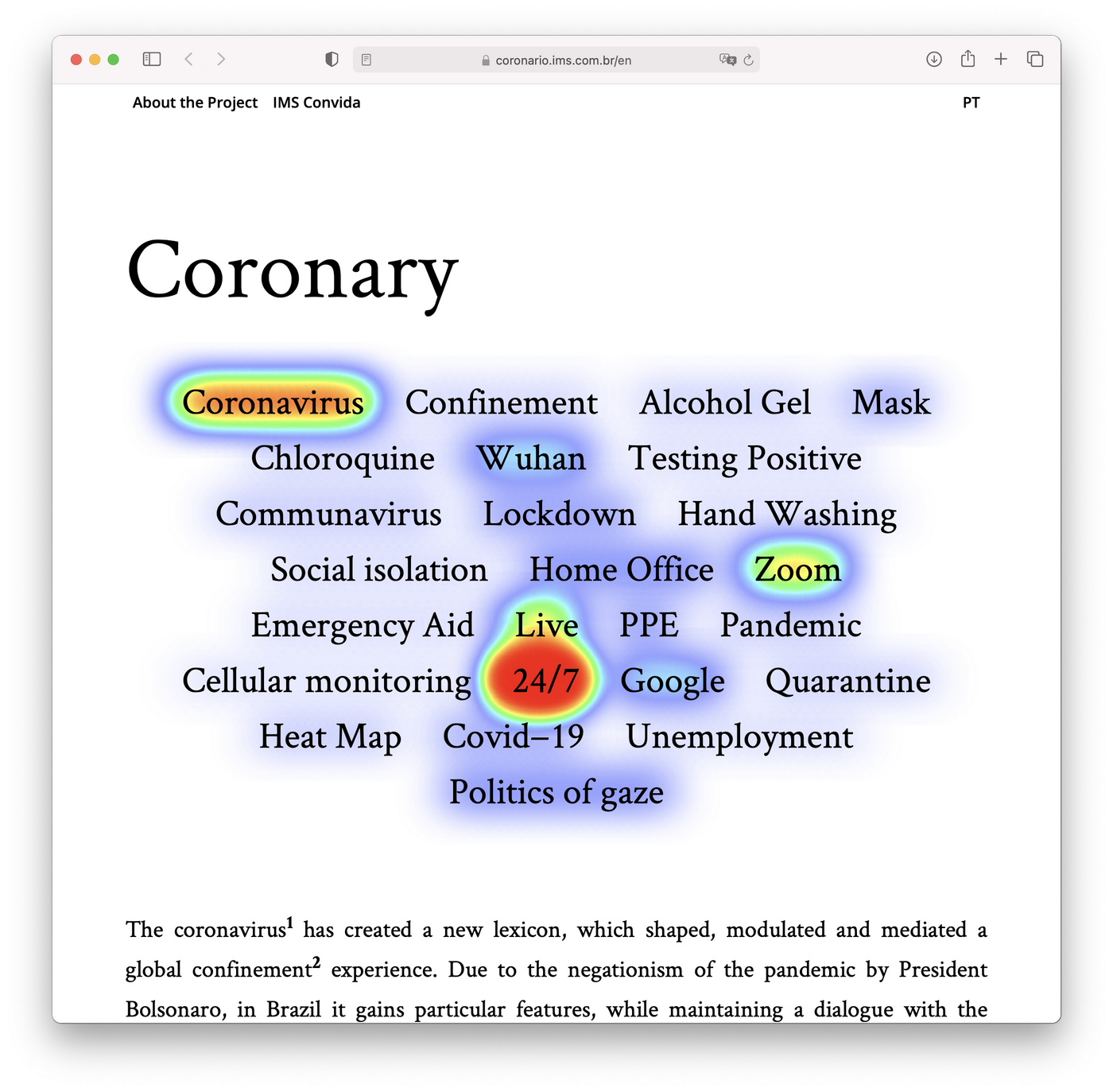
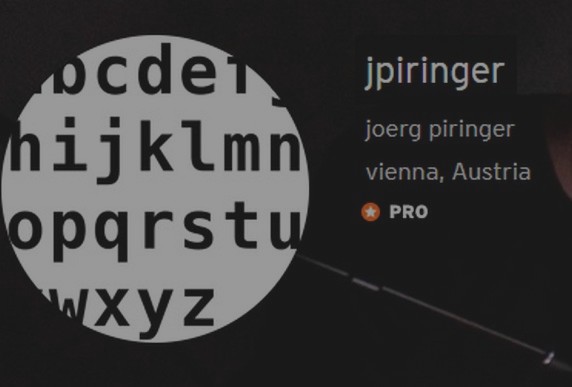
Jörg Piringer
The Complete COVID-19
Genome as a Sound Poem
link = The Complete COVID-19 Genome as a Sound Poem
Connection to Theme:
This is the complete genome of the Covid-19-virus as a soundpoem.
source:NIH Website
The Sequence:
ATTAAAGG
TTTATACC
TTCCCAGG
TAACAAAC
CAACCAAC
TTTCGATC
TCTTGTAG
ATCTGTTC
TCTAAACGAA...
Artwork Description:
Biography:
born 1974. currently living in vienna, austria. member of the institute for transacoustic research. member of the vegetable orchestra. master degree in computer science.works as a freelance artist and researcher in the fields of electronic music, radio art, sound and visual electronic poetry, interactive collaborative systems, online communities, live performance, sound installation, computer games and video art.
==>> Artist's Website


Piotr Marecki,
Kamil Gorgh Trzaska,
Krzysztof Kaz,
Michał Caruso
Polska przydrożna/
Roadside Poland
link =Download the work
Artwork Description:
“Polska przydrożna” ("Roadside Poland") is an anti-racer designed for the 8-bit Atari, immersed in demoscene aesthetics and the general climate of retro games. The program references the book "Polska przydrożna" by Piotr Marecki (Wydawnictwo Czarne, 2020), which describes a road trip along Polish side roads. Instead of straightforward travelling, the protagonist of the book wriggles around small towns (these locations are listed in the form of a text scroll).
The demo itself is devoid of elements characteristic of racers (car, speed, movement, attractive landscapes), thus the work testifies to the pandemic time in which it was made (sports matches without spectators, universities without students, peopleless tourist destinations). The chiptune composed by Caruso refers to Polish disco-polo folk music (designed on Raster Music Tracker). The demo is programmed using MADS assembler. Demo made by Gorgh (code), Maro (idea), Caruso (msx), Kaz (gfx), 2020.
Biography:
Piotr Maro Marecki - associate professor (Jagiellonian University), digital media artist and scholar, writer. Head of the UBU lab (ubulab.edu.pl) and Ha!art Publishing House (ha.art.pl). Based in Kraków.
Kamil Gorgh Trzaska (1983) - involved in various programming projects. Creator and administrator of https://mechanism.fr site focused on new retro games. Based in Warsaw.
Krzysztof Kaz Ziembik - pixel-art artist, game designer and creator for vintage computer platforms. Lecturer, researcher, and journalist in the field of computer science history, demoscene and game culture. Founder of AtariOnline.pl. Based in Wrocław.
Michał Caruso Brzeziecki - chiptune musician.
==>> AtariOnline.pl

René Bauer
Beat Suter
ToniZ
link = ToniZ
Connection to Theme:
ToniZ.ch is the twin of the Toni Areal, the building where the Zurich University of the Arts is housed in. With the lockdown in place in March 2020, the building was shut off completely for several months. The ToniZ.ch is a try to gain back some grounds for students and teachers. ToniZ.ch is a symbolic and ironic confrontation with the university building. Similarities with exsting institutions and people are incidental. Bachelor and Master graduation celebrations were held in ToniZ.ch with all students and teachers present and able to interact with each other.
Artwork Description:
toniZ.ch - or forcing the virtual down the throat of the analog. It may even be understood as a design method. toniZ.ch is oriented towards a culture of software that has been liberated from legal constraints. Crackers call software that is free from piracy protection mechanisms gamez or warez. toniZ is the attempt to free a (university) building at least a little bit from its legalistic, institutional rules and constraints. In the virtual environment imagination and subjective memories take over and offer other possibilities than reality does. It is precisely the virtual that for years would have offered the opportunity to rethink, to reshape our environment, precisely by letting the virtual overwrite the analog. Visually the whole thing comes along as a 80/90s multiplayer point and click adventure. The software was originally developed by Paolo Pedercini, Molleindustria.com (OpenSource) for an event that was no longer possible due to COVID-19 and then further developed with its own inventory or display of Youtube, links directly in the content. The software works with ProcessingJS/5p.js and with NodeJs in the backend.
Biography:
René Bauer is founding member of the artgroup AND-OR. He has an M.A. degree in German philology and literary studies, biology and computer linguistics from the University of Zurich. Presently, he works at the Zurich University of the Arts (ZHdK) in Switzerland as lecturer, researcher and head of Master’s education in the subject area of Game Design. He also manages the GameLab together with Beat Suter. His interests encompass coding, game mechanics, game studies, art in/with games (www.and-or.ch) and social media/knowledge systems (www.ixistenz.ch).
Beat Suter is founding member of the artgroup AND-OR. He is senior lecturer for Game Design at Zurich University of the Arts (ZHdK) in Switzerland, specializing in concepts, storytelling, mechanics and the history of games. He manages the GameLab (gamelab.zhdk.ch) together with René Bauer. He holds a doctorate in literature from the University of Zurich, with a focus on digital literature. For some years Suter has worked as lecturer for the Merz Academy Stuttgart, as project manager for a communications agency and as publisher of books and electronic literature (edition cyberfiction and netzliteratur.net). He also works as an independent scholar and curator, and as editor and author (cybersuter.ch).
Dr. Sullivan is the designer of Loominary – a digital game system controlled with a loom - which has shown internationally, including the SAAM Arcade at the Smithsonian American Art Museum.
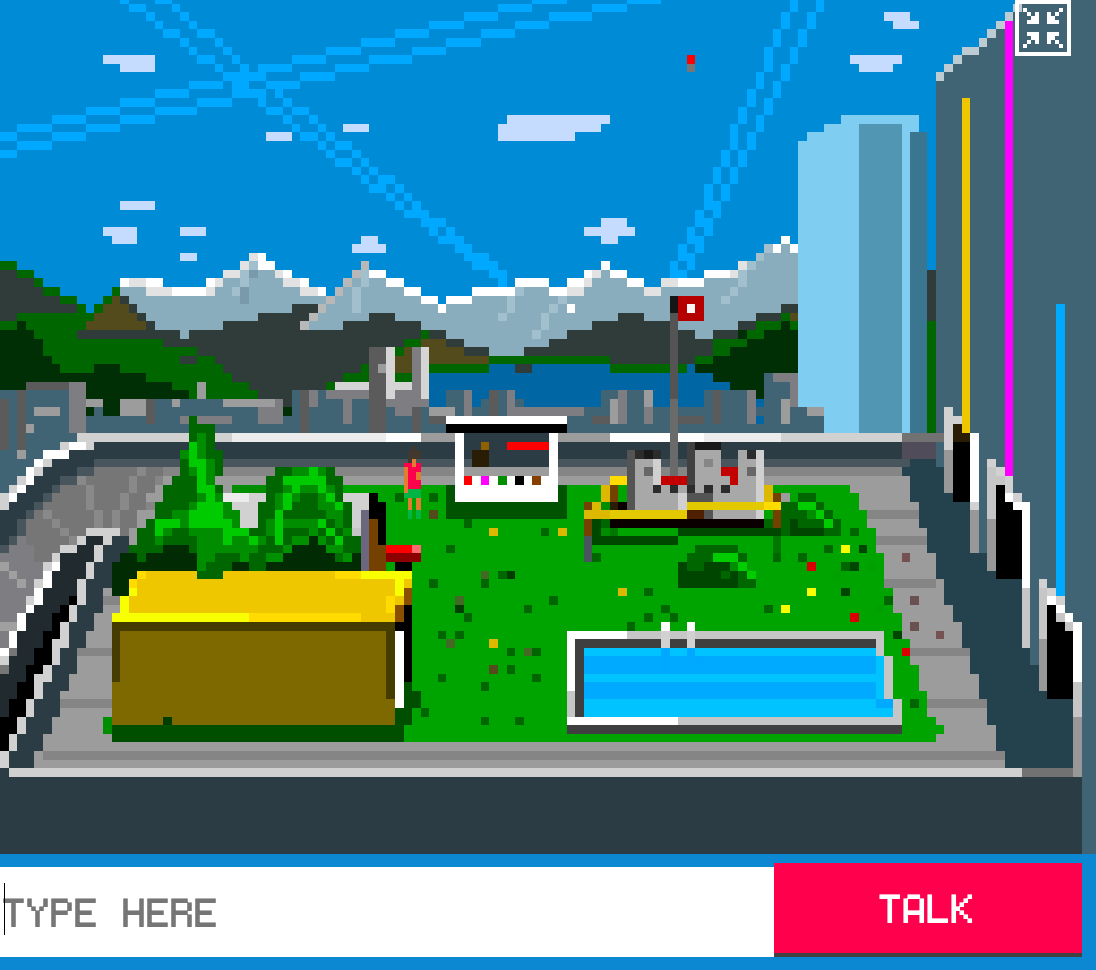


Judy Malloy
link =merged with the screen for days
Connection to Theme:
In the first column, backgrounded by the Lagado Engine, some of the texts are taken from The Roar of Destiny, a work I began in 1995, while I was working full time online for Arts Wire. In The Roar of Destiny, I wanted to simulate the merging of real life and online life that occurred when at least half of one's life was spent online. I recall that we thought that many other people would soon be working in this way. But that did not happen until 2020, when it was mandated by an epidemic. The other columns were written in response to COVID-isolation. The title, merged with the screen for days, is taken from a line in The Roar of Destiny.
Artwork Description:
Simulating computer-mediated environments that dominated our lives in 2020, in merged with the screen for days, computer-generated stanzas that move across a four-array structure play unpredictably together -- allowing, if the reader generates several versions, multiple views. The history of generative poetry is referenced in the background by Jonathan Swift's Lagado Engine from Gulliver's Travels. (the drawing probably did not appear until the 1727 third edition). Swift imagined this engine as a satire that predicted where literature, art, and science would go astray centuries later. But for years, I have been haunted by the beauty of his illustration.
Biography:
My work with computer-mediated generative literature began in 1988 with the generative hypertext system that I devised for the third file of Uncle Roger and subsequently used to create its name was Penelope in 1989. In my creative practice, a literary "engine" -- that I design, code, and write -- seeks to fulfill an individual vision that would be difficult to convey in print.
==>> Artist's Website
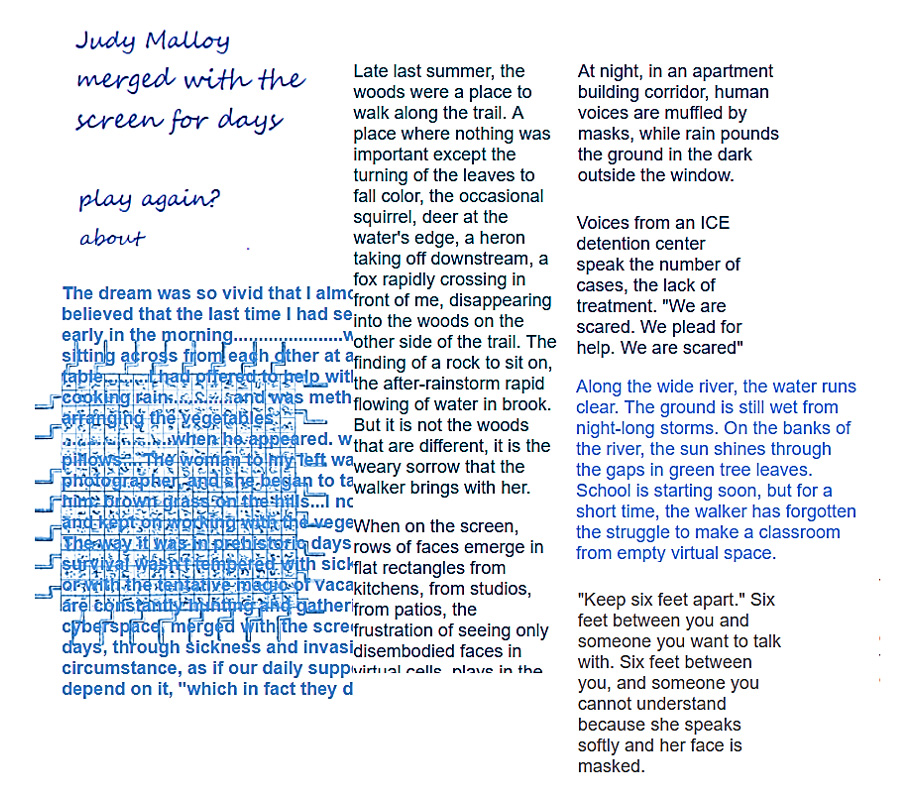
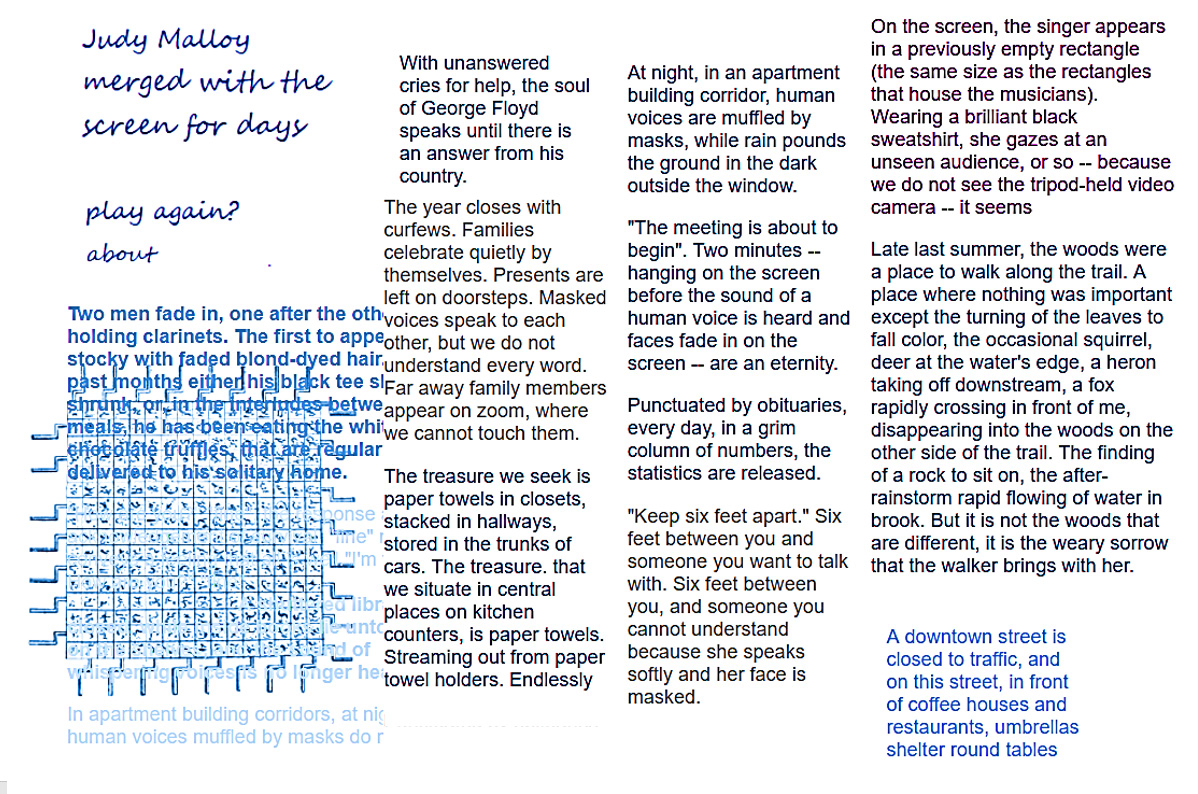

Patrick Lichty
Confinement Spaces:
Isolation and
Loss in the Pandemic
link =Confinement Spaces
Connection to Theme:
Confinement Spaces is an existential visual narrative of living in the United Arab Emirates under lockdown from March-August 2020. The initial days of the lockdown, when work turned to Zoom-time and simple actions like grocery shopping became an exercise in epidemiology, created a mix of anxiety and ennui that led to scanning the environment with an iPhone and 3D scanning software, creating beautiful, glitched dreamlike landscapes.
As time passed and restrictions eased, other spaces, like the Cultural Foundation and Louvre Abu Dhabi opened again, and the artist went out to progressively scan the pandemic landscape. Eventually restrictions eased to allow travel to the other Emirates, and sites in Dubai, Sharjah, and the legendary airplane from the movie Lord of War (in Umm al Quwain) were captured as an allegory for the universality of the isolation being experienced in the UAE and around the globe.
Artwork Description:
The result is a visual narrative of the glitched landscape of the pandemic UAE, six months collapsed into a single experience (following the author's work in Spatial Form), as a series of twelve interactive spaces rendered as pastiches of the 82 scanned spaces made during this time. The project proposed is an initial version created for The Foundry in Dubai, and the ELO version will incproporate deeper narratological structures in text, spoken word and video.
Biography:
Patrick is a conceptual artist, curator, and theorist exploring how media shape our perception of reality as well as the borders between the digital and the material. He is best known for his work with the virtual reality performance art group Second Front, and the animator of the activist group, The Yes Men. He is a CalArts/Herb Alpert Fellow and Whitney Biennial exhibitor as part of the collective RTMark. He has presented and exhibited internationally at numerous biennials and triennials (Yokohama, Venice, Performa, Maribor, Turin, Sundance), and conferences (ISEA, SIGGRAPH, Popular Culture Association, SLSA, SxSW). His recent book, “Variant Analyses: Interrogations of New Media Culture” was released by the Institute for Networked Culture and is included in the Oxford Handbook of Virtuality.
==>> Artist's Website
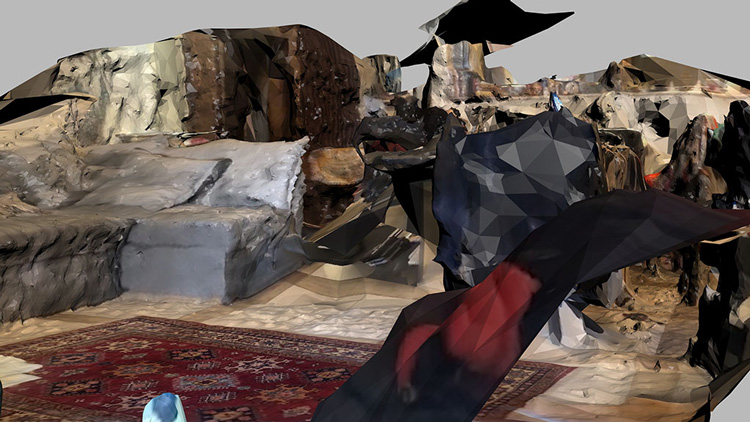

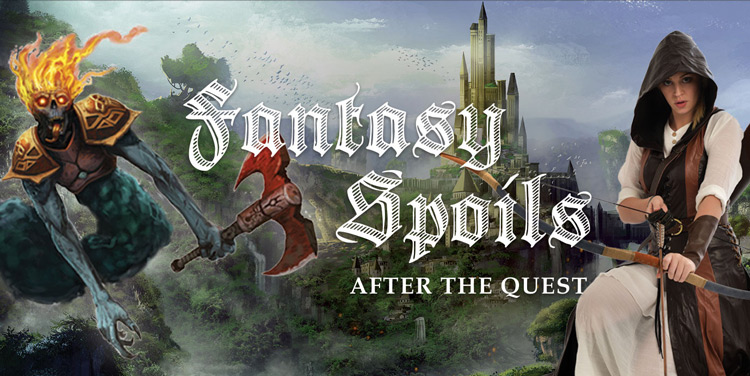
Haunted Blessings
"How I learned to cherish life after a trip to hell"
When I was in the islands nearly a generation ago, I was acquainted with a young American couple who had among their belongings an attractive little son of the age of seven—attractive but not practicably companionable with me, because he knew no English. He had played from his birth with the little Kanakas on his father’s plantation, and had preferred their language and would learn no other. The family removed to America a month after I arrived in the islands, and straightway the boy began to lose his Kanaka and pick up English. By the time he was twelve he hadn’t a word of Kanaka left; the language had wholly departed from his tongue and from his comprehension. Nine years later, when he was twenty-one, I came upon the family in one of the lake towns of New York, and the mother told me about an adventure which her son had been having. By trade he was now a professional diver. A passenger boat had been caught in a storm on the lake, and had gone down, carrying her people with her. A few days later the young diver descended, with his armor on, and entered the berth-saloon of the boat, and stood at the foot of the companionway, with his hand on the rail, peering through the dim water. Presently something touched him on the shoulder, and he turned and found a dead man swaying and bobbing about him and seemingly inspecting him inquiringly. He was paralyzed with fright.
His entry had disturbed the water, and now he discerned a number of dim corpses making for him and wagging their heads and swaying their bodies like sleepy people trying to dance. His senses forsook him, and in that condition he was drawn to the surface. He was put to bed at home, and was soon very ill. During some days he had seasons of delirium which lasted several hours at a time; and while they lasted he talked Kanaka incessantly and glibly; and Kanaka only. He was still very ill, and he talked to me in that tongue; but I did not understand it, of course. The doctor-books tell us that cases like this are not uncommon. Then the doctors ought to study the cases and find out how to multiply them. Many languages and things get mislaid in a person’s head, and stay mislaid for lack of this remedy.
Several of our passengers belonged in Honolulu, and these were sent ashore; but nobody could go ashore and return. There were people on shore who were booked to go with us to Australia, but we could not receive them; to do it would cost us a quarantine-term in Sydney. They could have escaped the day before, by ship to San Francisco; but the bars had been put up, now, and they might have to wait weeks before any ship could venture to give them a passage any whither. And there were hardships for others. An elderly lady and her son, recreation-seekers from Massachusetts, had wandered westward, further and further from home, always intending to take the return track, but always concluding to go still a little further; and now here they were at anchor before Honolulu positively their last westward-bound indulgence—they had made up their minds to that—but where is the use in making up your mind in this world? It is usually a waste of time to do it. These two would have to stay with us as far as Australia. Then they could go on around the world, or go back the way they had come; the distance and the accommodations and outlay of time would be just the same, whichever of the two routes they might elect to take. Think of it: a projected excursion of five hundred miles gradually enlarged, without any elaborate degree of intention, to a possible twenty-four thousand. However, they were used to extensions by this time, and did not mind this new one much.



















